Preparation of Accounting Records using Spreadsheets
VerifiedAdded on 2023/04/21
|17
|4867
|127
AI Summary
This document provides a detailed explanation of how to prepare accounting records using spreadsheets. It includes examples of journal entries, ledger accounts, and adjusting entries. The document also discusses the types of adjusting entries and provides a worksheet, statement of profit/loss, balance sheet, and statement of changes in equity.
Contribute Materials
Your contribution can guide someone’s learning journey. Share your
documents today.
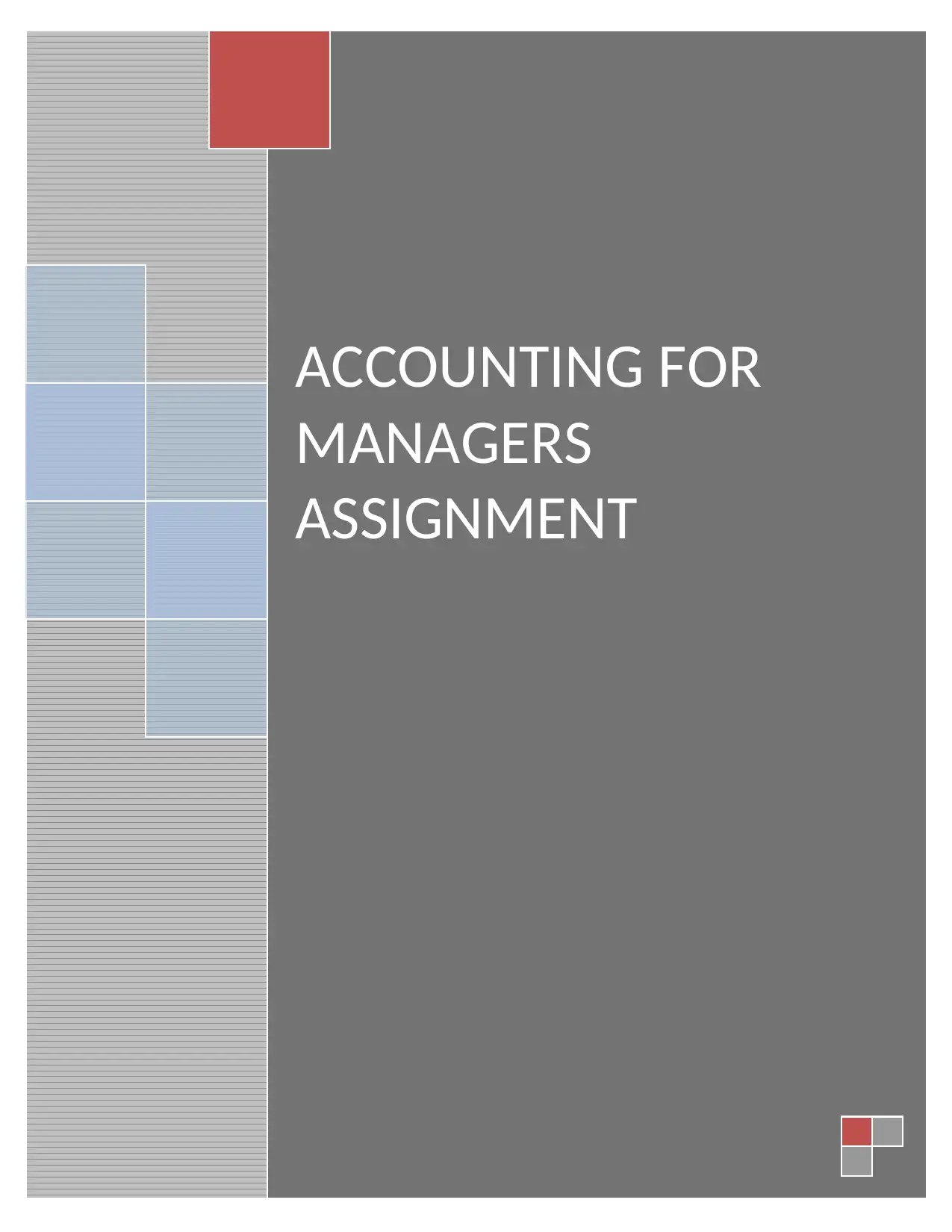
ACCOUNTING FOR
MANAGERS
ASSIGNMENT
MANAGERS
ASSIGNMENT
Secure Best Marks with AI Grader
Need help grading? Try our AI Grader for instant feedback on your assignments.
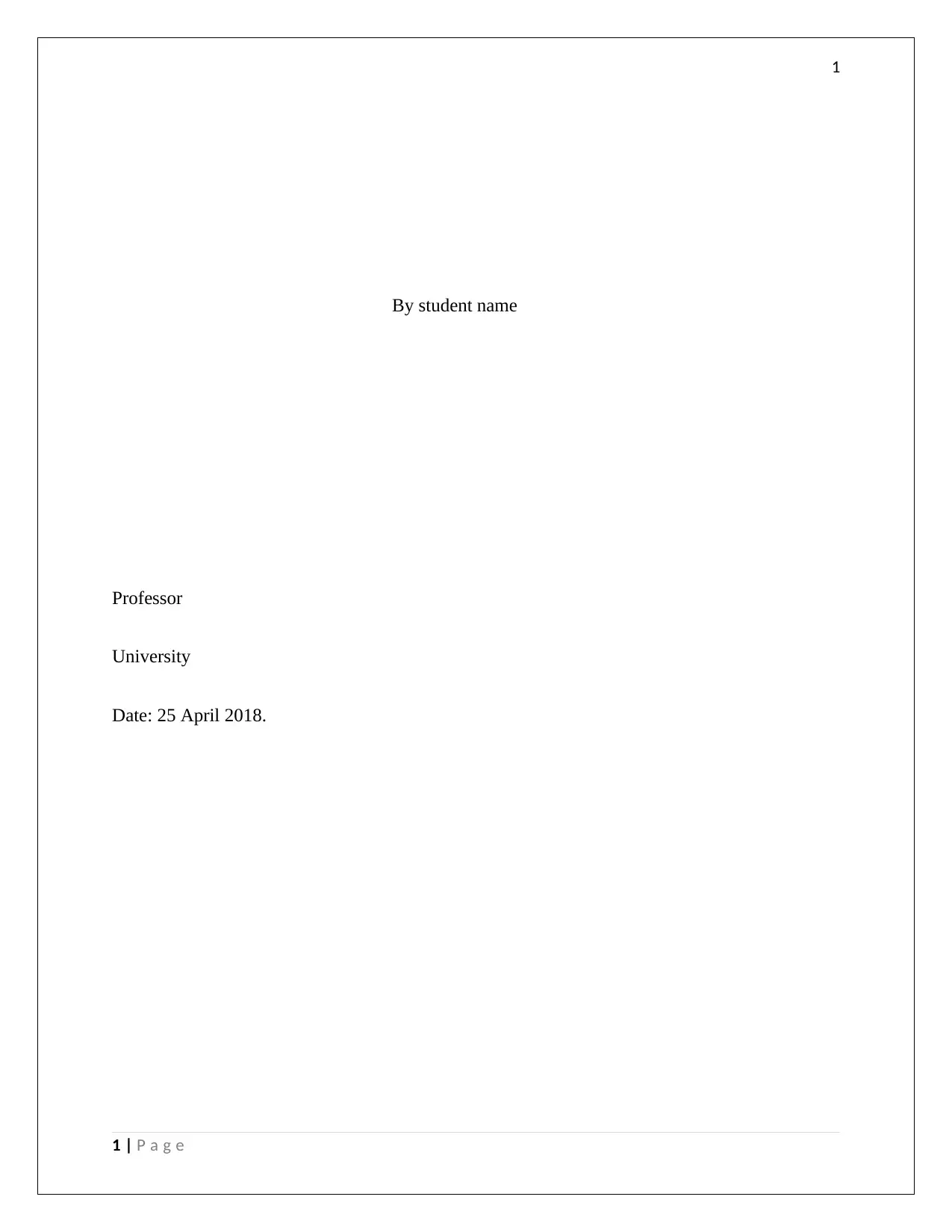
1
By student name
Professor
University
Date: 25 April 2018.
1 | P a g e
By student name
Professor
University
Date: 25 April 2018.
1 | P a g e
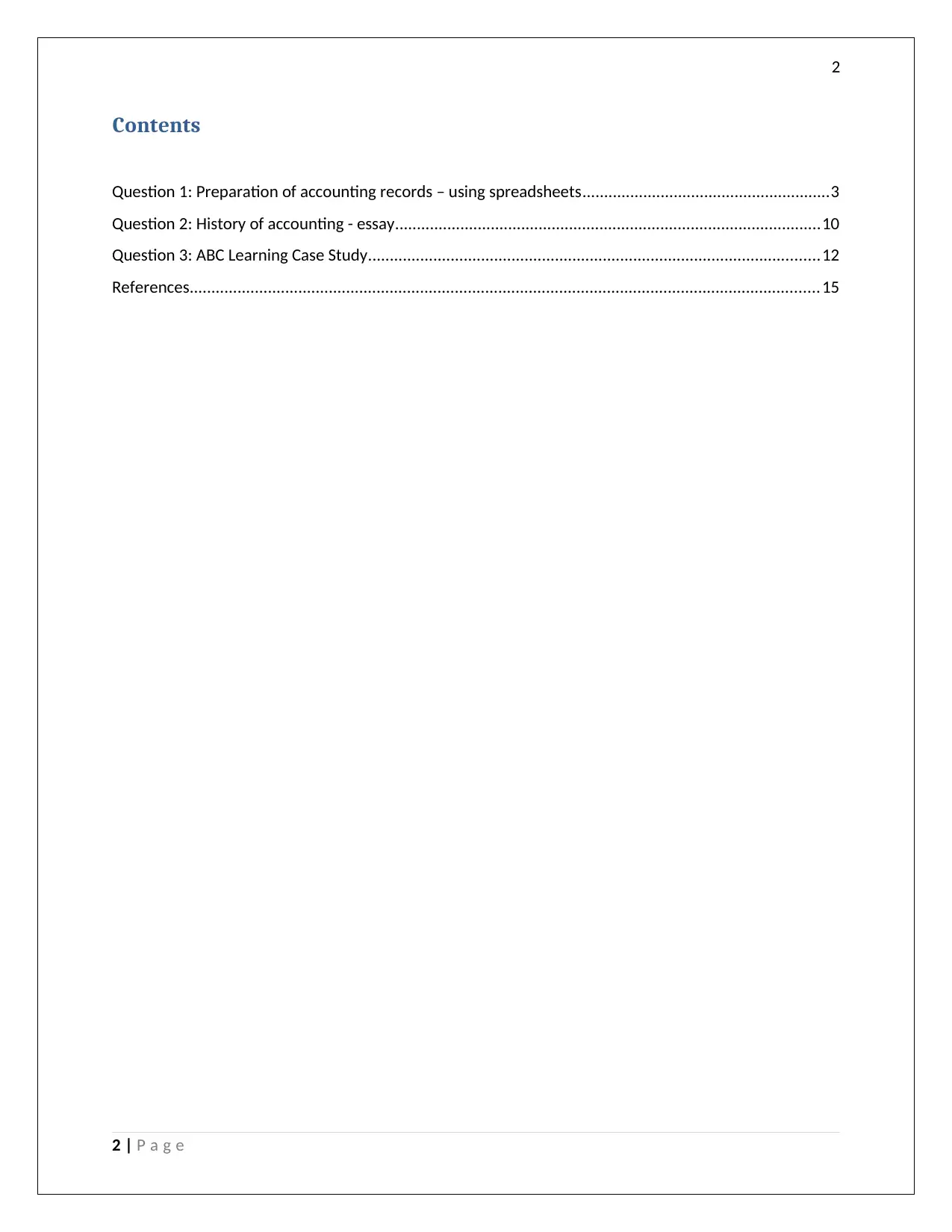
2
Contents
Question 1: Preparation of accounting records – using spreadsheets.........................................................3
Question 2: History of accounting - essay..................................................................................................10
Question 3: ABC Learning Case Study........................................................................................................12
References.................................................................................................................................................15
2 | P a g e
Contents
Question 1: Preparation of accounting records – using spreadsheets.........................................................3
Question 2: History of accounting - essay..................................................................................................10
Question 3: ABC Learning Case Study........................................................................................................12
References.................................................................................................................................................15
2 | P a g e
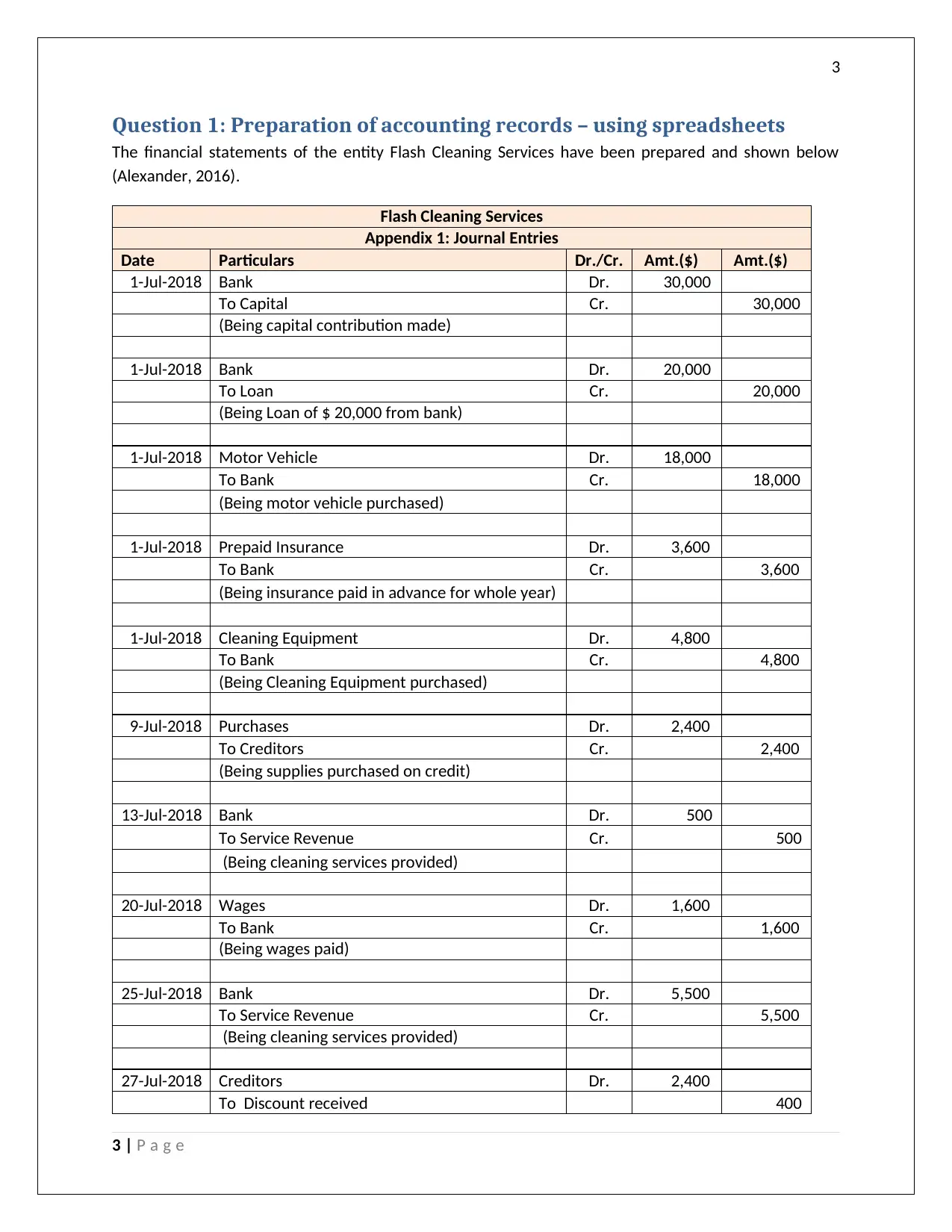
3
Question 1: Preparation of accounting records – using spreadsheets
The financial statements of the entity Flash Cleaning Services have been prepared and shown below
(Alexander, 2016).
Flash Cleaning Services
Appendix 1: Journal Entries
Date Particulars Dr./Cr. Amt.($) Amt.($)
1-Jul-2018 Bank Dr. 30,000
To Capital Cr. 30,000
(Being capital contribution made)
1-Jul-2018 Bank Dr. 20,000
To Loan Cr. 20,000
(Being Loan of $ 20,000 from bank)
1-Jul-2018 Motor Vehicle Dr. 18,000
To Bank Cr. 18,000
(Being motor vehicle purchased)
1-Jul-2018 Prepaid Insurance Dr. 3,600
To Bank Cr. 3,600
(Being insurance paid in advance for whole year)
1-Jul-2018 Cleaning Equipment Dr. 4,800
To Bank Cr. 4,800
(Being Cleaning Equipment purchased)
9-Jul-2018 Purchases Dr. 2,400
To Creditors Cr. 2,400
(Being supplies purchased on credit)
13-Jul-2018 Bank Dr. 500
To Service Revenue Cr. 500
(Being cleaning services provided)
20-Jul-2018 Wages Dr. 1,600
To Bank Cr. 1,600
(Being wages paid)
25-Jul-2018 Bank Dr. 5,500
To Service Revenue Cr. 5,500
(Being cleaning services provided)
27-Jul-2018 Creditors Dr. 2,400
To Discount received 400
3 | P a g e
Question 1: Preparation of accounting records – using spreadsheets
The financial statements of the entity Flash Cleaning Services have been prepared and shown below
(Alexander, 2016).
Flash Cleaning Services
Appendix 1: Journal Entries
Date Particulars Dr./Cr. Amt.($) Amt.($)
1-Jul-2018 Bank Dr. 30,000
To Capital Cr. 30,000
(Being capital contribution made)
1-Jul-2018 Bank Dr. 20,000
To Loan Cr. 20,000
(Being Loan of $ 20,000 from bank)
1-Jul-2018 Motor Vehicle Dr. 18,000
To Bank Cr. 18,000
(Being motor vehicle purchased)
1-Jul-2018 Prepaid Insurance Dr. 3,600
To Bank Cr. 3,600
(Being insurance paid in advance for whole year)
1-Jul-2018 Cleaning Equipment Dr. 4,800
To Bank Cr. 4,800
(Being Cleaning Equipment purchased)
9-Jul-2018 Purchases Dr. 2,400
To Creditors Cr. 2,400
(Being supplies purchased on credit)
13-Jul-2018 Bank Dr. 500
To Service Revenue Cr. 500
(Being cleaning services provided)
20-Jul-2018 Wages Dr. 1,600
To Bank Cr. 1,600
(Being wages paid)
25-Jul-2018 Bank Dr. 5,500
To Service Revenue Cr. 5,500
(Being cleaning services provided)
27-Jul-2018 Creditors Dr. 2,400
To Discount received 400
3 | P a g e
Secure Best Marks with AI Grader
Need help grading? Try our AI Grader for instant feedback on your assignments.
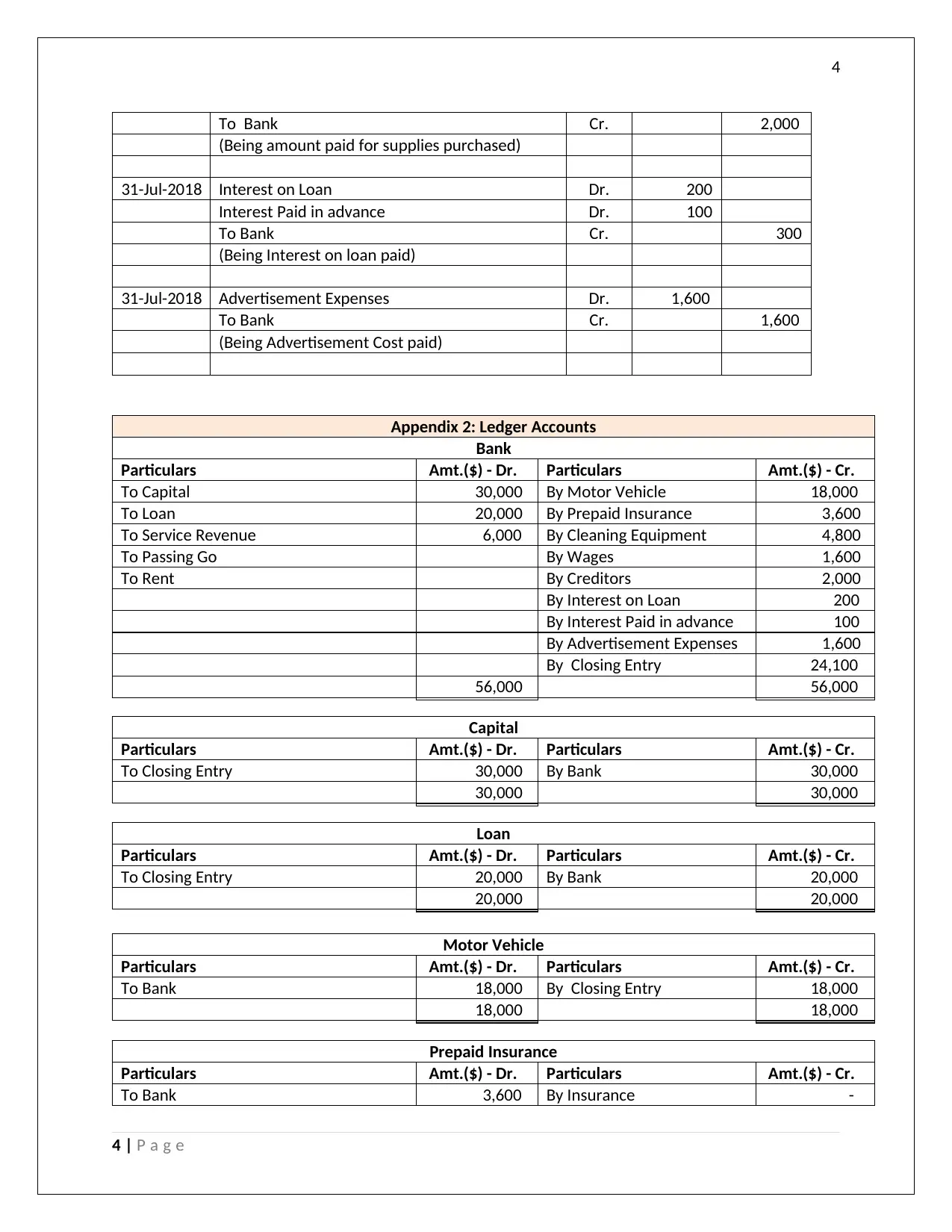
4
To Bank Cr. 2,000
(Being amount paid for supplies purchased)
31-Jul-2018 Interest on Loan Dr. 200
Interest Paid in advance Dr. 100
To Bank Cr. 300
(Being Interest on loan paid)
31-Jul-2018 Advertisement Expenses Dr. 1,600
To Bank Cr. 1,600
(Being Advertisement Cost paid)
Appendix 2: Ledger Accounts
Bank
Particulars Amt.($) - Dr. Particulars Amt.($) - Cr.
To Capital 30,000 By Motor Vehicle 18,000
To Loan 20,000 By Prepaid Insurance 3,600
To Service Revenue 6,000 By Cleaning Equipment 4,800
To Passing Go By Wages 1,600
To Rent By Creditors 2,000
By Interest on Loan 200
By Interest Paid in advance 100
By Advertisement Expenses 1,600
By Closing Entry 24,100
56,000 56,000
Capital
Particulars Amt.($) - Dr. Particulars Amt.($) - Cr.
To Closing Entry 30,000 By Bank 30,000
30,000 30,000
Loan
Particulars Amt.($) - Dr. Particulars Amt.($) - Cr.
To Closing Entry 20,000 By Bank 20,000
20,000 20,000
Motor Vehicle
Particulars Amt.($) - Dr. Particulars Amt.($) - Cr.
To Bank 18,000 By Closing Entry 18,000
18,000 18,000
Prepaid Insurance
Particulars Amt.($) - Dr. Particulars Amt.($) - Cr.
To Bank 3,600 By Insurance -
4 | P a g e
To Bank Cr. 2,000
(Being amount paid for supplies purchased)
31-Jul-2018 Interest on Loan Dr. 200
Interest Paid in advance Dr. 100
To Bank Cr. 300
(Being Interest on loan paid)
31-Jul-2018 Advertisement Expenses Dr. 1,600
To Bank Cr. 1,600
(Being Advertisement Cost paid)
Appendix 2: Ledger Accounts
Bank
Particulars Amt.($) - Dr. Particulars Amt.($) - Cr.
To Capital 30,000 By Motor Vehicle 18,000
To Loan 20,000 By Prepaid Insurance 3,600
To Service Revenue 6,000 By Cleaning Equipment 4,800
To Passing Go By Wages 1,600
To Rent By Creditors 2,000
By Interest on Loan 200
By Interest Paid in advance 100
By Advertisement Expenses 1,600
By Closing Entry 24,100
56,000 56,000
Capital
Particulars Amt.($) - Dr. Particulars Amt.($) - Cr.
To Closing Entry 30,000 By Bank 30,000
30,000 30,000
Loan
Particulars Amt.($) - Dr. Particulars Amt.($) - Cr.
To Closing Entry 20,000 By Bank 20,000
20,000 20,000
Motor Vehicle
Particulars Amt.($) - Dr. Particulars Amt.($) - Cr.
To Bank 18,000 By Closing Entry 18,000
18,000 18,000
Prepaid Insurance
Particulars Amt.($) - Dr. Particulars Amt.($) - Cr.
To Bank 3,600 By Insurance -
4 | P a g e
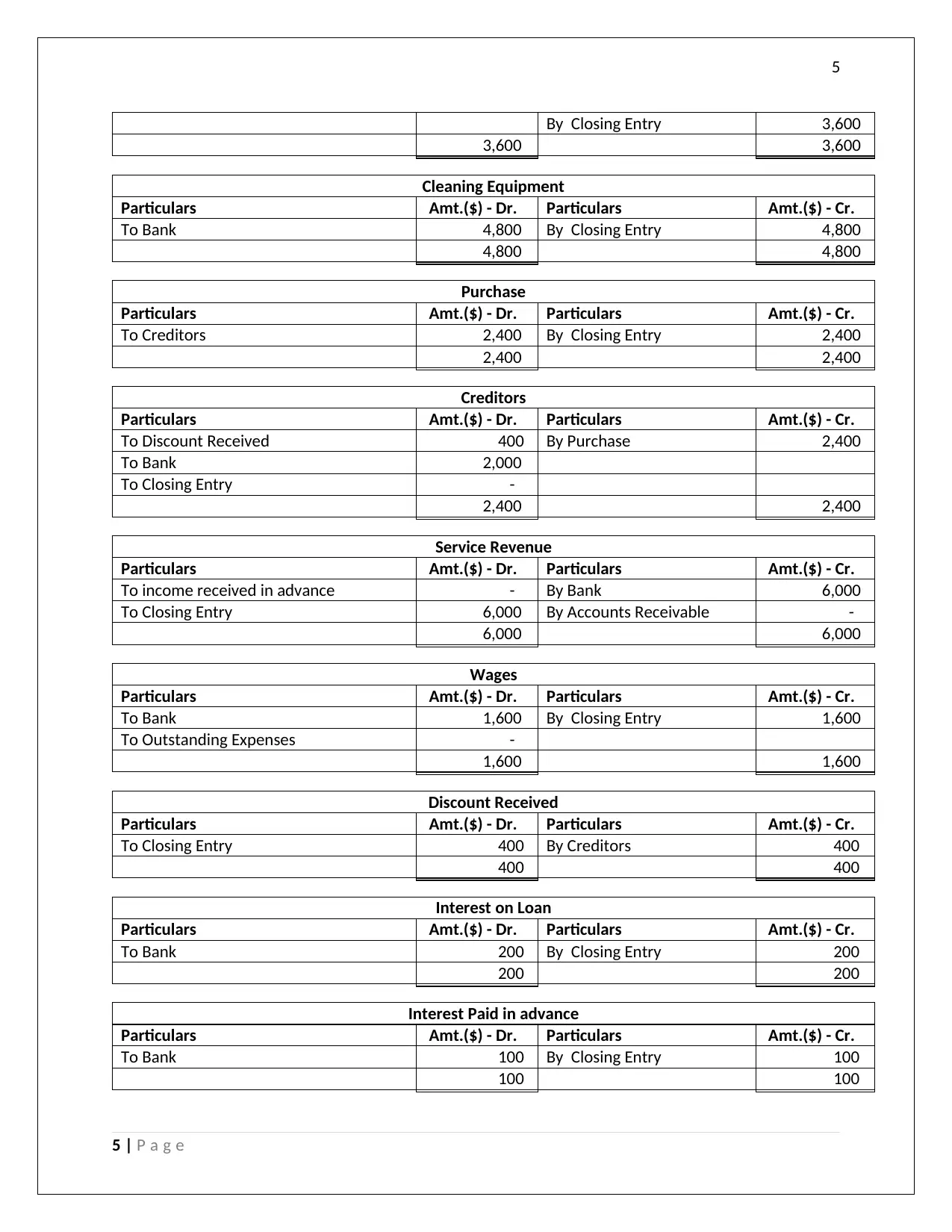
5
By Closing Entry 3,600
3,600 3,600
Cleaning Equipment
Particulars Amt.($) - Dr. Particulars Amt.($) - Cr.
To Bank 4,800 By Closing Entry 4,800
4,800 4,800
Purchase
Particulars Amt.($) - Dr. Particulars Amt.($) - Cr.
To Creditors 2,400 By Closing Entry 2,400
2,400 2,400
Creditors
Particulars Amt.($) - Dr. Particulars Amt.($) - Cr.
To Discount Received 400 By Purchase 2,400
To Bank 2,000
To Closing Entry -
2,400 2,400
Service Revenue
Particulars Amt.($) - Dr. Particulars Amt.($) - Cr.
To income received in advance - By Bank 6,000
To Closing Entry 6,000 By Accounts Receivable -
6,000 6,000
Wages
Particulars Amt.($) - Dr. Particulars Amt.($) - Cr.
To Bank 1,600 By Closing Entry 1,600
To Outstanding Expenses -
1,600 1,600
Discount Received
Particulars Amt.($) - Dr. Particulars Amt.($) - Cr.
To Closing Entry 400 By Creditors 400
400 400
Interest on Loan
Particulars Amt.($) - Dr. Particulars Amt.($) - Cr.
To Bank 200 By Closing Entry 200
200 200
Interest Paid in advance
Particulars Amt.($) - Dr. Particulars Amt.($) - Cr.
To Bank 100 By Closing Entry 100
100 100
5 | P a g e
By Closing Entry 3,600
3,600 3,600
Cleaning Equipment
Particulars Amt.($) - Dr. Particulars Amt.($) - Cr.
To Bank 4,800 By Closing Entry 4,800
4,800 4,800
Purchase
Particulars Amt.($) - Dr. Particulars Amt.($) - Cr.
To Creditors 2,400 By Closing Entry 2,400
2,400 2,400
Creditors
Particulars Amt.($) - Dr. Particulars Amt.($) - Cr.
To Discount Received 400 By Purchase 2,400
To Bank 2,000
To Closing Entry -
2,400 2,400
Service Revenue
Particulars Amt.($) - Dr. Particulars Amt.($) - Cr.
To income received in advance - By Bank 6,000
To Closing Entry 6,000 By Accounts Receivable -
6,000 6,000
Wages
Particulars Amt.($) - Dr. Particulars Amt.($) - Cr.
To Bank 1,600 By Closing Entry 1,600
To Outstanding Expenses -
1,600 1,600
Discount Received
Particulars Amt.($) - Dr. Particulars Amt.($) - Cr.
To Closing Entry 400 By Creditors 400
400 400
Interest on Loan
Particulars Amt.($) - Dr. Particulars Amt.($) - Cr.
To Bank 200 By Closing Entry 200
200 200
Interest Paid in advance
Particulars Amt.($) - Dr. Particulars Amt.($) - Cr.
To Bank 100 By Closing Entry 100
100 100
5 | P a g e
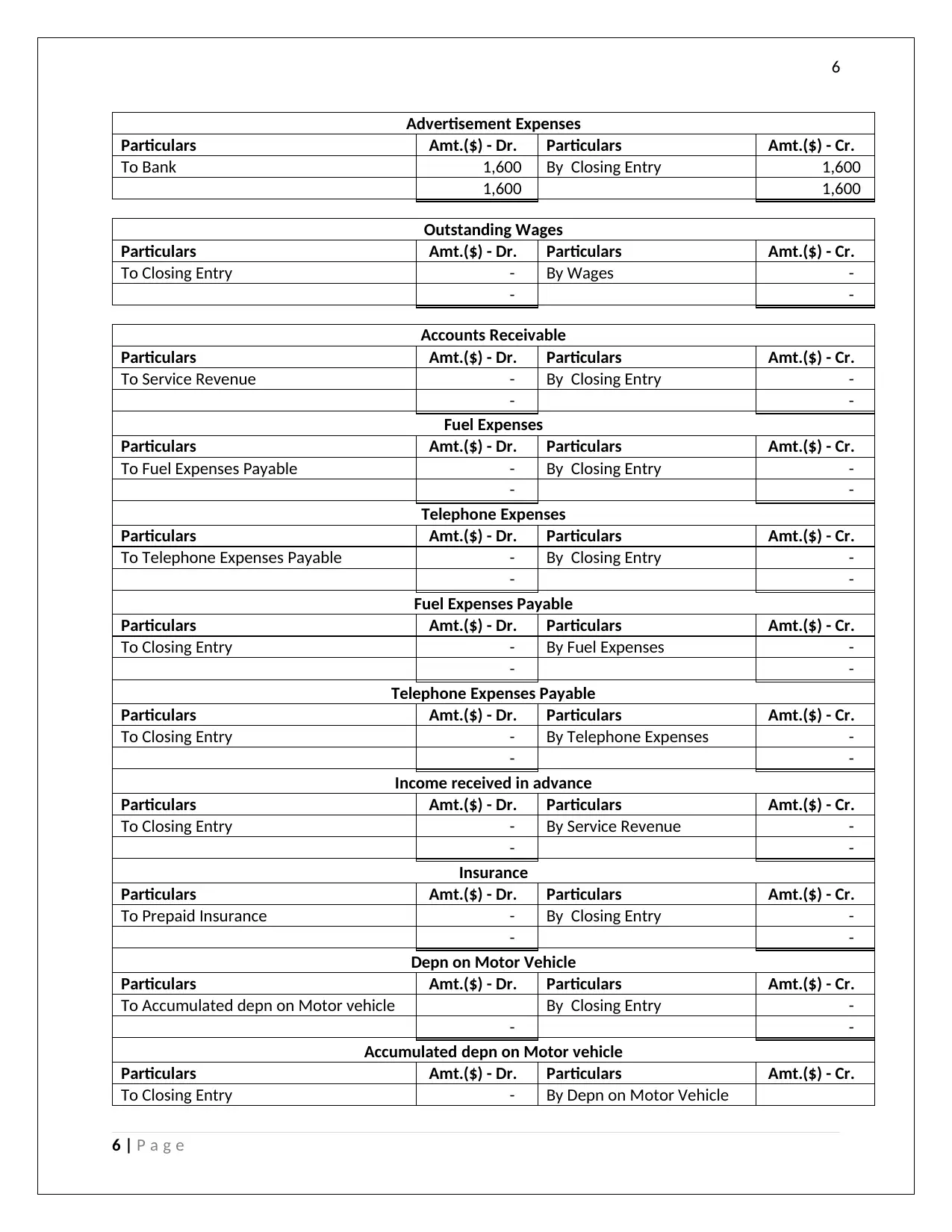
6
Advertisement Expenses
Particulars Amt.($) - Dr. Particulars Amt.($) - Cr.
To Bank 1,600 By Closing Entry 1,600
1,600 1,600
Outstanding Wages
Particulars Amt.($) - Dr. Particulars Amt.($) - Cr.
To Closing Entry - By Wages -
- -
Accounts Receivable
Particulars Amt.($) - Dr. Particulars Amt.($) - Cr.
To Service Revenue - By Closing Entry -
- -
Fuel Expenses
Particulars Amt.($) - Dr. Particulars Amt.($) - Cr.
To Fuel Expenses Payable - By Closing Entry -
- -
Telephone Expenses
Particulars Amt.($) - Dr. Particulars Amt.($) - Cr.
To Telephone Expenses Payable - By Closing Entry -
- -
Fuel Expenses Payable
Particulars Amt.($) - Dr. Particulars Amt.($) - Cr.
To Closing Entry - By Fuel Expenses -
- -
Telephone Expenses Payable
Particulars Amt.($) - Dr. Particulars Amt.($) - Cr.
To Closing Entry - By Telephone Expenses -
- -
Income received in advance
Particulars Amt.($) - Dr. Particulars Amt.($) - Cr.
To Closing Entry - By Service Revenue -
- -
Insurance
Particulars Amt.($) - Dr. Particulars Amt.($) - Cr.
To Prepaid Insurance - By Closing Entry -
- -
Depn on Motor Vehicle
Particulars Amt.($) - Dr. Particulars Amt.($) - Cr.
To Accumulated depn on Motor vehicle By Closing Entry -
- -
Accumulated depn on Motor vehicle
Particulars Amt.($) - Dr. Particulars Amt.($) - Cr.
To Closing Entry - By Depn on Motor Vehicle
6 | P a g e
Advertisement Expenses
Particulars Amt.($) - Dr. Particulars Amt.($) - Cr.
To Bank 1,600 By Closing Entry 1,600
1,600 1,600
Outstanding Wages
Particulars Amt.($) - Dr. Particulars Amt.($) - Cr.
To Closing Entry - By Wages -
- -
Accounts Receivable
Particulars Amt.($) - Dr. Particulars Amt.($) - Cr.
To Service Revenue - By Closing Entry -
- -
Fuel Expenses
Particulars Amt.($) - Dr. Particulars Amt.($) - Cr.
To Fuel Expenses Payable - By Closing Entry -
- -
Telephone Expenses
Particulars Amt.($) - Dr. Particulars Amt.($) - Cr.
To Telephone Expenses Payable - By Closing Entry -
- -
Fuel Expenses Payable
Particulars Amt.($) - Dr. Particulars Amt.($) - Cr.
To Closing Entry - By Fuel Expenses -
- -
Telephone Expenses Payable
Particulars Amt.($) - Dr. Particulars Amt.($) - Cr.
To Closing Entry - By Telephone Expenses -
- -
Income received in advance
Particulars Amt.($) - Dr. Particulars Amt.($) - Cr.
To Closing Entry - By Service Revenue -
- -
Insurance
Particulars Amt.($) - Dr. Particulars Amt.($) - Cr.
To Prepaid Insurance - By Closing Entry -
- -
Depn on Motor Vehicle
Particulars Amt.($) - Dr. Particulars Amt.($) - Cr.
To Accumulated depn on Motor vehicle By Closing Entry -
- -
Accumulated depn on Motor vehicle
Particulars Amt.($) - Dr. Particulars Amt.($) - Cr.
To Closing Entry - By Depn on Motor Vehicle
6 | P a g e
Paraphrase This Document
Need a fresh take? Get an instant paraphrase of this document with our AI Paraphraser
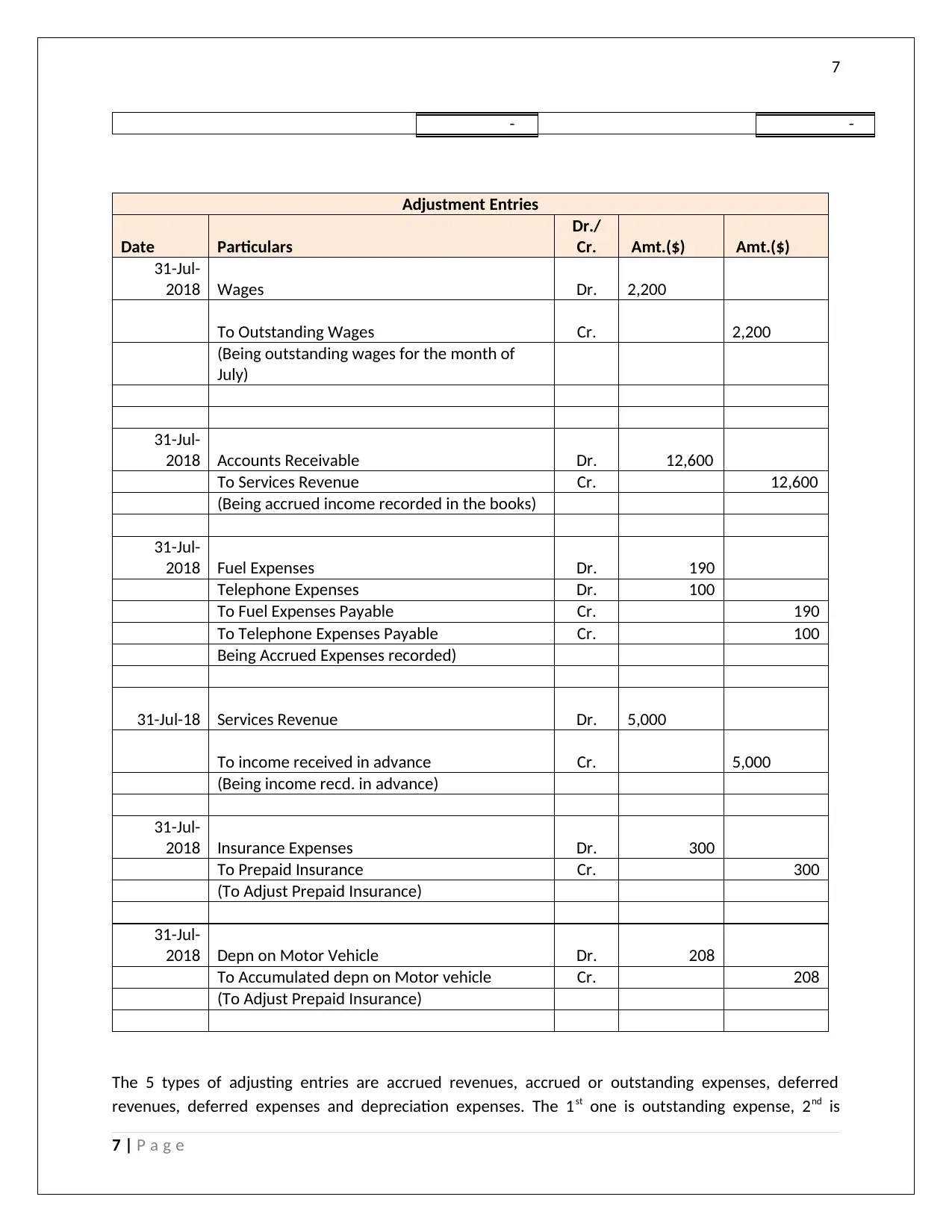
7
- -
Adjustment Entries
Date Particulars
Dr./
Cr. Amt.($) Amt.($)
31-Jul-
2018 Wages Dr. 2,200
To Outstanding Wages Cr. 2,200
(Being outstanding wages for the month of
July)
31-Jul-
2018 Accounts Receivable Dr. 12,600
To Services Revenue Cr. 12,600
(Being accrued income recorded in the books)
31-Jul-
2018 Fuel Expenses Dr. 190
Telephone Expenses Dr. 100
To Fuel Expenses Payable Cr. 190
To Telephone Expenses Payable Cr. 100
Being Accrued Expenses recorded)
31-Jul-18 Services Revenue Dr. 5,000
To income received in advance Cr. 5,000
(Being income recd. in advance)
31-Jul-
2018 Insurance Expenses Dr. 300
To Prepaid Insurance Cr. 300
(To Adjust Prepaid Insurance)
31-Jul-
2018 Depn on Motor Vehicle Dr. 208
To Accumulated depn on Motor vehicle Cr. 208
(To Adjust Prepaid Insurance)
The 5 types of adjusting entries are accrued revenues, accrued or outstanding expenses, deferred
revenues, deferred expenses and depreciation expenses. The 1st one is outstanding expense, 2nd is
7 | P a g e
- -
Adjustment Entries
Date Particulars
Dr./
Cr. Amt.($) Amt.($)
31-Jul-
2018 Wages Dr. 2,200
To Outstanding Wages Cr. 2,200
(Being outstanding wages for the month of
July)
31-Jul-
2018 Accounts Receivable Dr. 12,600
To Services Revenue Cr. 12,600
(Being accrued income recorded in the books)
31-Jul-
2018 Fuel Expenses Dr. 190
Telephone Expenses Dr. 100
To Fuel Expenses Payable Cr. 190
To Telephone Expenses Payable Cr. 100
Being Accrued Expenses recorded)
31-Jul-18 Services Revenue Dr. 5,000
To income received in advance Cr. 5,000
(Being income recd. in advance)
31-Jul-
2018 Insurance Expenses Dr. 300
To Prepaid Insurance Cr. 300
(To Adjust Prepaid Insurance)
31-Jul-
2018 Depn on Motor Vehicle Dr. 208
To Accumulated depn on Motor vehicle Cr. 208
(To Adjust Prepaid Insurance)
The 5 types of adjusting entries are accrued revenues, accrued or outstanding expenses, deferred
revenues, deferred expenses and depreciation expenses. The 1st one is outstanding expense, 2nd is
7 | P a g e
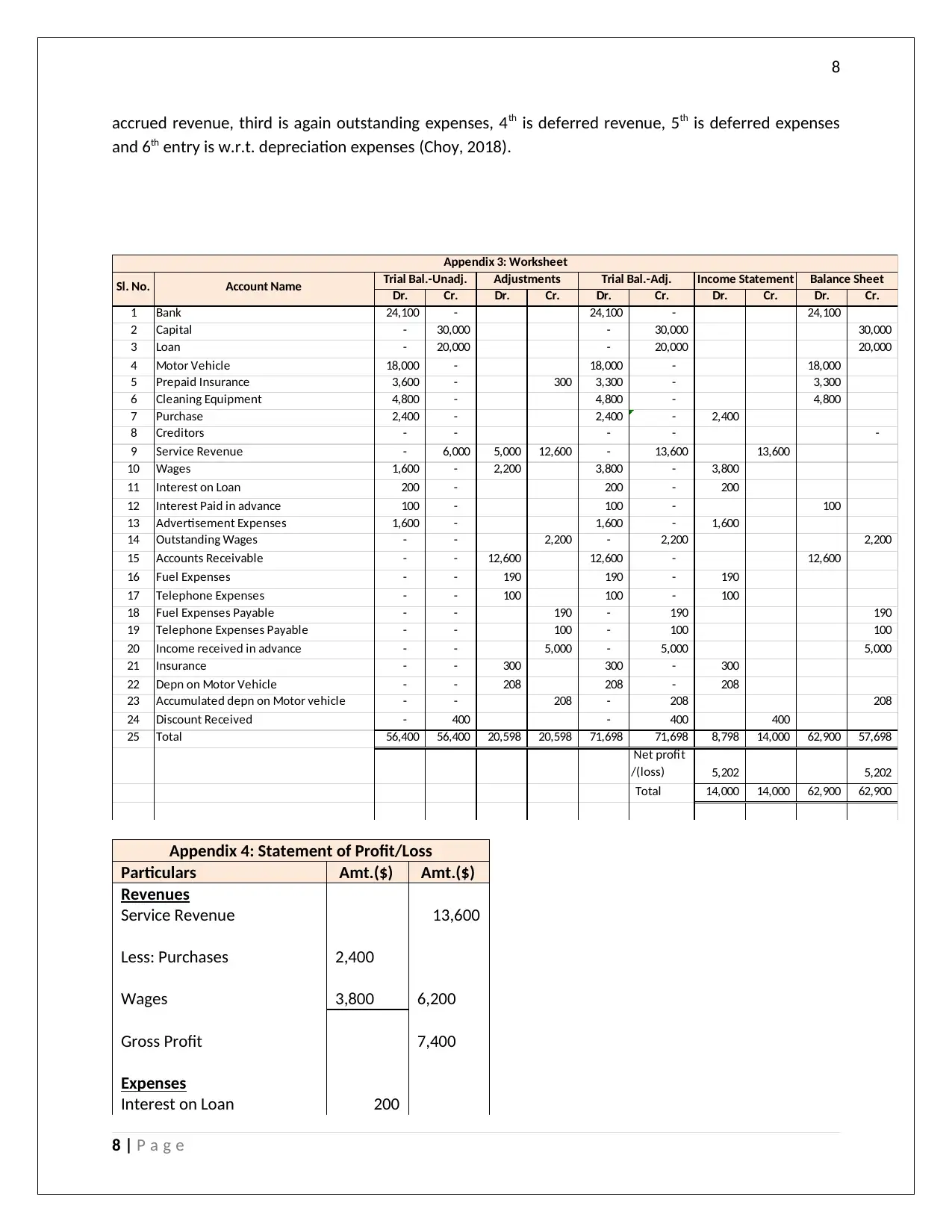
8
accrued revenue, third is again outstanding expenses, 4th is deferred revenue, 5th is deferred expenses
and 6th entry is w.r.t. depreciation expenses (Choy, 2018).
Dr. Cr. Dr. Cr. Dr. Cr. Dr. Cr. Dr. Cr.
1 Bank 24,100 - 24,100 - 24,100
2 Capital - 30,000 - 30,000 30,000
3 Loan - 20,000 - 20,000 20,000
4 Motor Vehicle 18,000 - 18,000 - 18,000
5 Prepaid Insurance 3,600 - 300 3,300 - 3,300
6 Cleaning Equipment 4,800 - 4,800 - 4,800
7 Purchase 2,400 - 2,400 - 2,400
8 Creditors - - - - -
9 Service Revenue - 6,000 5,000 12,600 - 13,600 13,600
10 Wages 1,600 - 2,200 3,800 - 3,800
11 Interest on Loan 200 - 200 - 200
12 Interest Paid in advance 100 - 100 - 100
13 Advertisement Expenses 1,600 - 1,600 - 1,600
14 Outstanding Wages - - 2,200 - 2,200 2,200
15 Accounts Receivable - - 12,600 12,600 - 12,600
16 Fuel Expenses - - 190 190 - 190
17 Telephone Expenses - - 100 100 - 100
18 Fuel Expenses Payable - - 190 - 190 190
19 Telephone Expenses Payable - - 100 - 100 100
20 Income received in advance - - 5,000 - 5,000 5,000
21 Insurance - - 300 300 - 300
22 Depn on Motor Vehicle - - 208 208 - 208
23 Accumulated depn on Motor vehicle - - 208 - 208 208
24 Discount Received - 400 - 400 400
25 Total 56,400 56,400 20,598 20,598 71,698 71,698 8,798 14,000 62,900 57,698
Net profit
/(loss) 5,202 5,202
Total 14,000 14,000 62,900 62,900
Account NameSl. No.
Appendix 3: Worksheet
Trial Bal.-Adj.Trial Bal.-Unadj. Adjustments Income Statement Balance Sheet
Appendix 4: Statement of Profit/Loss
Particulars Amt.($) Amt.($)
Revenues
Service Revenue 13,600
Less: Purchases 2,400
Wages 3,800 6,200
Gross Profit 7,400
Expenses
Interest on Loan 200
8 | P a g e
accrued revenue, third is again outstanding expenses, 4th is deferred revenue, 5th is deferred expenses
and 6th entry is w.r.t. depreciation expenses (Choy, 2018).
Dr. Cr. Dr. Cr. Dr. Cr. Dr. Cr. Dr. Cr.
1 Bank 24,100 - 24,100 - 24,100
2 Capital - 30,000 - 30,000 30,000
3 Loan - 20,000 - 20,000 20,000
4 Motor Vehicle 18,000 - 18,000 - 18,000
5 Prepaid Insurance 3,600 - 300 3,300 - 3,300
6 Cleaning Equipment 4,800 - 4,800 - 4,800
7 Purchase 2,400 - 2,400 - 2,400
8 Creditors - - - - -
9 Service Revenue - 6,000 5,000 12,600 - 13,600 13,600
10 Wages 1,600 - 2,200 3,800 - 3,800
11 Interest on Loan 200 - 200 - 200
12 Interest Paid in advance 100 - 100 - 100
13 Advertisement Expenses 1,600 - 1,600 - 1,600
14 Outstanding Wages - - 2,200 - 2,200 2,200
15 Accounts Receivable - - 12,600 12,600 - 12,600
16 Fuel Expenses - - 190 190 - 190
17 Telephone Expenses - - 100 100 - 100
18 Fuel Expenses Payable - - 190 - 190 190
19 Telephone Expenses Payable - - 100 - 100 100
20 Income received in advance - - 5,000 - 5,000 5,000
21 Insurance - - 300 300 - 300
22 Depn on Motor Vehicle - - 208 208 - 208
23 Accumulated depn on Motor vehicle - - 208 - 208 208
24 Discount Received - 400 - 400 400
25 Total 56,400 56,400 20,598 20,598 71,698 71,698 8,798 14,000 62,900 57,698
Net profit
/(loss) 5,202 5,202
Total 14,000 14,000 62,900 62,900
Account NameSl. No.
Appendix 3: Worksheet
Trial Bal.-Adj.Trial Bal.-Unadj. Adjustments Income Statement Balance Sheet
Appendix 4: Statement of Profit/Loss
Particulars Amt.($) Amt.($)
Revenues
Service Revenue 13,600
Less: Purchases 2,400
Wages 3,800 6,200
Gross Profit 7,400
Expenses
Interest on Loan 200
8 | P a g e

9
Advertisement Expenses 1,600
Fuel Expenses 190
Telephone Expenses 100
Insurance 300
Depn on Motor Vehicle 208
Discount Received (400) 2,198
Profit/(Loss) during the
game 5,202
Appendix 5: Statement of Financial Position
Particulars Amt.($) Amt.($)
Non-Current Assets
Motor Vehicle 18,000
Less: Acc. Depn on Motor
vehicle (208)
Cleaning Equipment 4,800 22,592
Current Assets
Bank 24,100
Prepaid Insurance 3,300
Interest Paid in advance 100
Accounts Receivable 12,600 40,100
Total Assets 62,692
Equity and Liabilities
Non-Current Liabilities
Loan 20,000
Current Liabilities
Outstanding Wages 2,200
Fuel Expenses Payable 190
Telephone Expenses Payable 100
Income received in advance 5,000 7,490
Equity
Capital 30,000
Add: Profit during the game 5,202 35,202
Total Equity and liabilities 62,692
9 | P a g e
Advertisement Expenses 1,600
Fuel Expenses 190
Telephone Expenses 100
Insurance 300
Depn on Motor Vehicle 208
Discount Received (400) 2,198
Profit/(Loss) during the
game 5,202
Appendix 5: Statement of Financial Position
Particulars Amt.($) Amt.($)
Non-Current Assets
Motor Vehicle 18,000
Less: Acc. Depn on Motor
vehicle (208)
Cleaning Equipment 4,800 22,592
Current Assets
Bank 24,100
Prepaid Insurance 3,300
Interest Paid in advance 100
Accounts Receivable 12,600 40,100
Total Assets 62,692
Equity and Liabilities
Non-Current Liabilities
Loan 20,000
Current Liabilities
Outstanding Wages 2,200
Fuel Expenses Payable 190
Telephone Expenses Payable 100
Income received in advance 5,000 7,490
Equity
Capital 30,000
Add: Profit during the game 5,202 35,202
Total Equity and liabilities 62,692
9 | P a g e
Secure Best Marks with AI Grader
Need help grading? Try our AI Grader for instant feedback on your assignments.
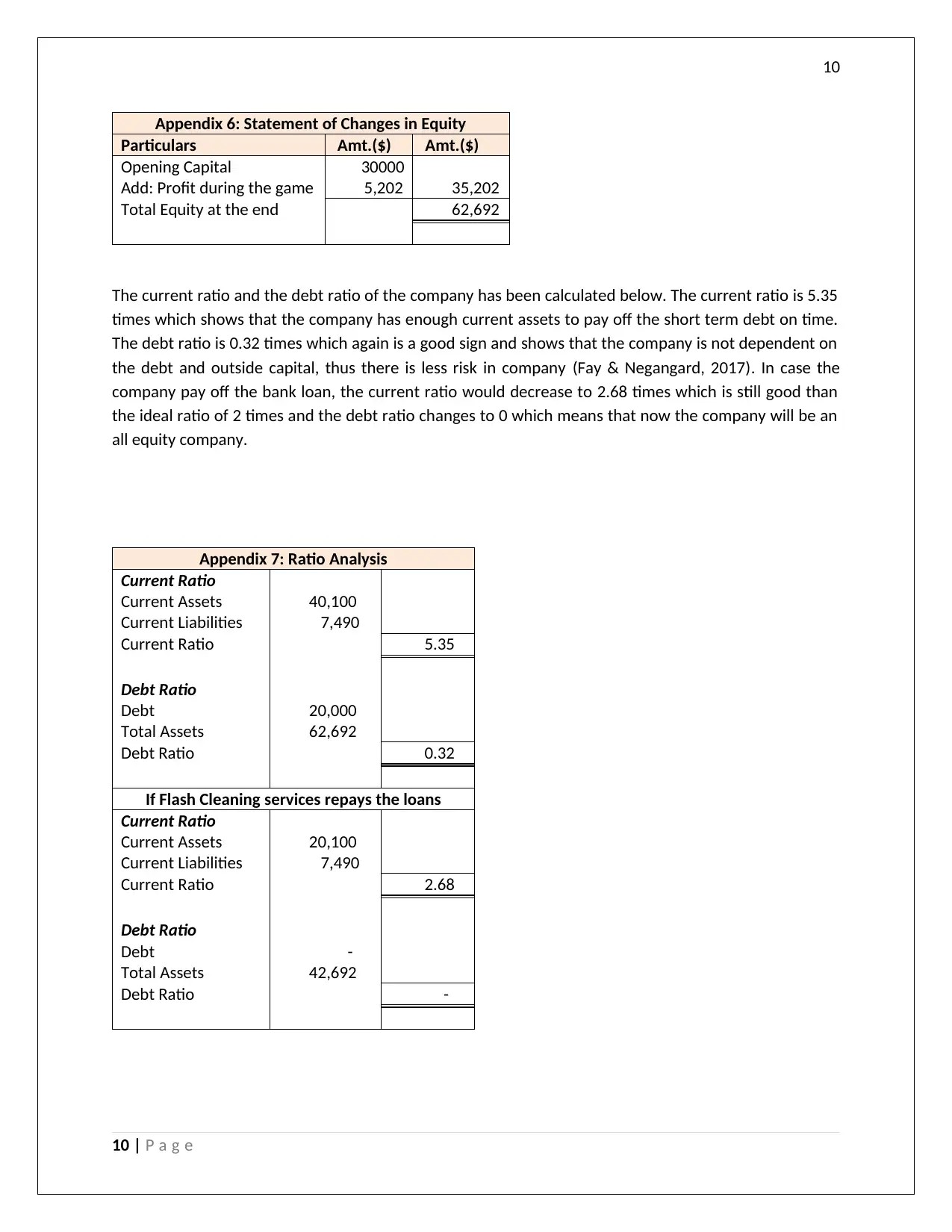
10
Appendix 6: Statement of Changes in Equity
Particulars Amt.($) Amt.($)
Opening Capital 30000
Add: Profit during the game 5,202 35,202
Total Equity at the end 62,692
The current ratio and the debt ratio of the company has been calculated below. The current ratio is 5.35
times which shows that the company has enough current assets to pay off the short term debt on time.
The debt ratio is 0.32 times which again is a good sign and shows that the company is not dependent on
the debt and outside capital, thus there is less risk in company (Fay & Negangard, 2017). In case the
company pay off the bank loan, the current ratio would decrease to 2.68 times which is still good than
the ideal ratio of 2 times and the debt ratio changes to 0 which means that now the company will be an
all equity company.
Appendix 7: Ratio Analysis
Current Ratio
Current Assets 40,100
Current Liabilities 7,490
Current Ratio 5.35
Debt Ratio
Debt 20,000
Total Assets 62,692
Debt Ratio 0.32
If Flash Cleaning services repays the loans
Current Ratio
Current Assets 20,100
Current Liabilities 7,490
Current Ratio 2.68
Debt Ratio
Debt -
Total Assets 42,692
Debt Ratio -
10 | P a g e
Appendix 6: Statement of Changes in Equity
Particulars Amt.($) Amt.($)
Opening Capital 30000
Add: Profit during the game 5,202 35,202
Total Equity at the end 62,692
The current ratio and the debt ratio of the company has been calculated below. The current ratio is 5.35
times which shows that the company has enough current assets to pay off the short term debt on time.
The debt ratio is 0.32 times which again is a good sign and shows that the company is not dependent on
the debt and outside capital, thus there is less risk in company (Fay & Negangard, 2017). In case the
company pay off the bank loan, the current ratio would decrease to 2.68 times which is still good than
the ideal ratio of 2 times and the debt ratio changes to 0 which means that now the company will be an
all equity company.
Appendix 7: Ratio Analysis
Current Ratio
Current Assets 40,100
Current Liabilities 7,490
Current Ratio 5.35
Debt Ratio
Debt 20,000
Total Assets 62,692
Debt Ratio 0.32
If Flash Cleaning services repays the loans
Current Ratio
Current Assets 20,100
Current Liabilities 7,490
Current Ratio 2.68
Debt Ratio
Debt -
Total Assets 42,692
Debt Ratio -
10 | P a g e
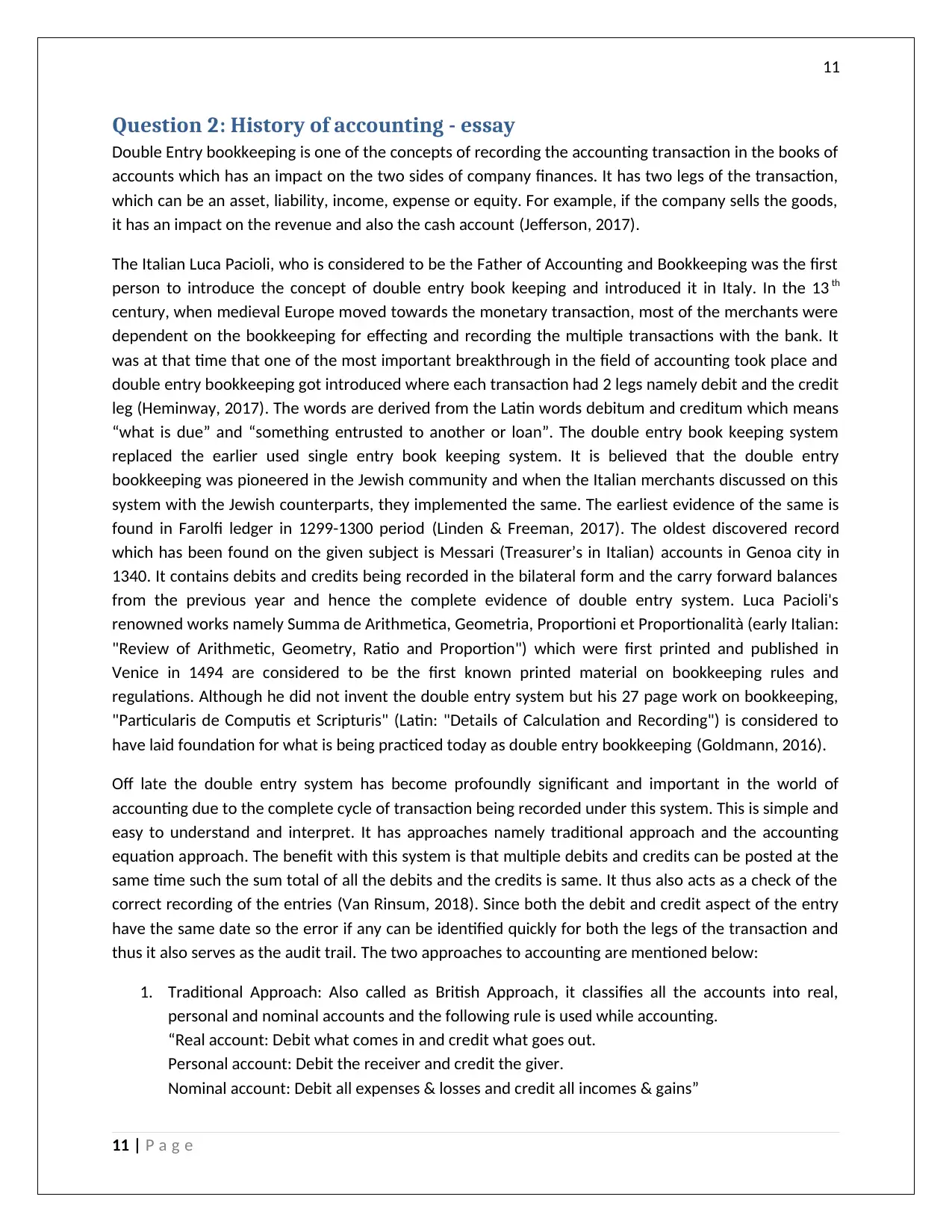
11
Question 2: History of accounting - essay
Double Entry bookkeeping is one of the concepts of recording the accounting transaction in the books of
accounts which has an impact on the two sides of company finances. It has two legs of the transaction,
which can be an asset, liability, income, expense or equity. For example, if the company sells the goods,
it has an impact on the revenue and also the cash account (Jefferson, 2017).
The Italian Luca Pacioli, who is considered to be the Father of Accounting and Bookkeeping was the first
person to introduce the concept of double entry book keeping and introduced it in Italy. In the 13 th
century, when medieval Europe moved towards the monetary transaction, most of the merchants were
dependent on the bookkeeping for effecting and recording the multiple transactions with the bank. It
was at that time that one of the most important breakthrough in the field of accounting took place and
double entry bookkeeping got introduced where each transaction had 2 legs namely debit and the credit
leg (Heminway, 2017). The words are derived from the Latin words debitum and creditum which means
“what is due” and “something entrusted to another or loan”. The double entry book keeping system
replaced the earlier used single entry book keeping system. It is believed that the double entry
bookkeeping was pioneered in the Jewish community and when the Italian merchants discussed on this
system with the Jewish counterparts, they implemented the same. The earliest evidence of the same is
found in Farolfi ledger in 1299-1300 period (Linden & Freeman, 2017). The oldest discovered record
which has been found on the given subject is Messari (Treasurer’s in Italian) accounts in Genoa city in
1340. It contains debits and credits being recorded in the bilateral form and the carry forward balances
from the previous year and hence the complete evidence of double entry system. Luca Pacioli's
renowned works namely Summa de Arithmetica, Geometria, Proportioni et Proportionalità (early Italian:
"Review of Arithmetic, Geometry, Ratio and Proportion") which were first printed and published in
Venice in 1494 are considered to be the first known printed material on bookkeeping rules and
regulations. Although he did not invent the double entry system but his 27 page work on bookkeeping,
"Particularis de Computis et Scripturis" (Latin: "Details of Calculation and Recording") is considered to
have laid foundation for what is being practiced today as double entry bookkeeping (Goldmann, 2016).
Off late the double entry system has become profoundly significant and important in the world of
accounting due to the complete cycle of transaction being recorded under this system. This is simple and
easy to understand and interpret. It has approaches namely traditional approach and the accounting
equation approach. The benefit with this system is that multiple debits and credits can be posted at the
same time such the sum total of all the debits and the credits is same. It thus also acts as a check of the
correct recording of the entries (Van Rinsum, 2018). Since both the debit and credit aspect of the entry
have the same date so the error if any can be identified quickly for both the legs of the transaction and
thus it also serves as the audit trail. The two approaches to accounting are mentioned below:
1. Traditional Approach: Also called as British Approach, it classifies all the accounts into real,
personal and nominal accounts and the following rule is used while accounting.
“Real account: Debit what comes in and credit what goes out.
Personal account: Debit the receiver and credit the giver.
Nominal account: Debit all expenses & losses and credit all incomes & gains”
11 | P a g e
Question 2: History of accounting - essay
Double Entry bookkeeping is one of the concepts of recording the accounting transaction in the books of
accounts which has an impact on the two sides of company finances. It has two legs of the transaction,
which can be an asset, liability, income, expense or equity. For example, if the company sells the goods,
it has an impact on the revenue and also the cash account (Jefferson, 2017).
The Italian Luca Pacioli, who is considered to be the Father of Accounting and Bookkeeping was the first
person to introduce the concept of double entry book keeping and introduced it in Italy. In the 13 th
century, when medieval Europe moved towards the monetary transaction, most of the merchants were
dependent on the bookkeeping for effecting and recording the multiple transactions with the bank. It
was at that time that one of the most important breakthrough in the field of accounting took place and
double entry bookkeeping got introduced where each transaction had 2 legs namely debit and the credit
leg (Heminway, 2017). The words are derived from the Latin words debitum and creditum which means
“what is due” and “something entrusted to another or loan”. The double entry book keeping system
replaced the earlier used single entry book keeping system. It is believed that the double entry
bookkeeping was pioneered in the Jewish community and when the Italian merchants discussed on this
system with the Jewish counterparts, they implemented the same. The earliest evidence of the same is
found in Farolfi ledger in 1299-1300 period (Linden & Freeman, 2017). The oldest discovered record
which has been found on the given subject is Messari (Treasurer’s in Italian) accounts in Genoa city in
1340. It contains debits and credits being recorded in the bilateral form and the carry forward balances
from the previous year and hence the complete evidence of double entry system. Luca Pacioli's
renowned works namely Summa de Arithmetica, Geometria, Proportioni et Proportionalità (early Italian:
"Review of Arithmetic, Geometry, Ratio and Proportion") which were first printed and published in
Venice in 1494 are considered to be the first known printed material on bookkeeping rules and
regulations. Although he did not invent the double entry system but his 27 page work on bookkeeping,
"Particularis de Computis et Scripturis" (Latin: "Details of Calculation and Recording") is considered to
have laid foundation for what is being practiced today as double entry bookkeeping (Goldmann, 2016).
Off late the double entry system has become profoundly significant and important in the world of
accounting due to the complete cycle of transaction being recorded under this system. This is simple and
easy to understand and interpret. It has approaches namely traditional approach and the accounting
equation approach. The benefit with this system is that multiple debits and credits can be posted at the
same time such the sum total of all the debits and the credits is same. It thus also acts as a check of the
correct recording of the entries (Van Rinsum, 2018). Since both the debit and credit aspect of the entry
have the same date so the error if any can be identified quickly for both the legs of the transaction and
thus it also serves as the audit trail. The two approaches to accounting are mentioned below:
1. Traditional Approach: Also called as British Approach, it classifies all the accounts into real,
personal and nominal accounts and the following rule is used while accounting.
“Real account: Debit what comes in and credit what goes out.
Personal account: Debit the receiver and credit the giver.
Nominal account: Debit all expenses & losses and credit all incomes & gains”
11 | P a g e
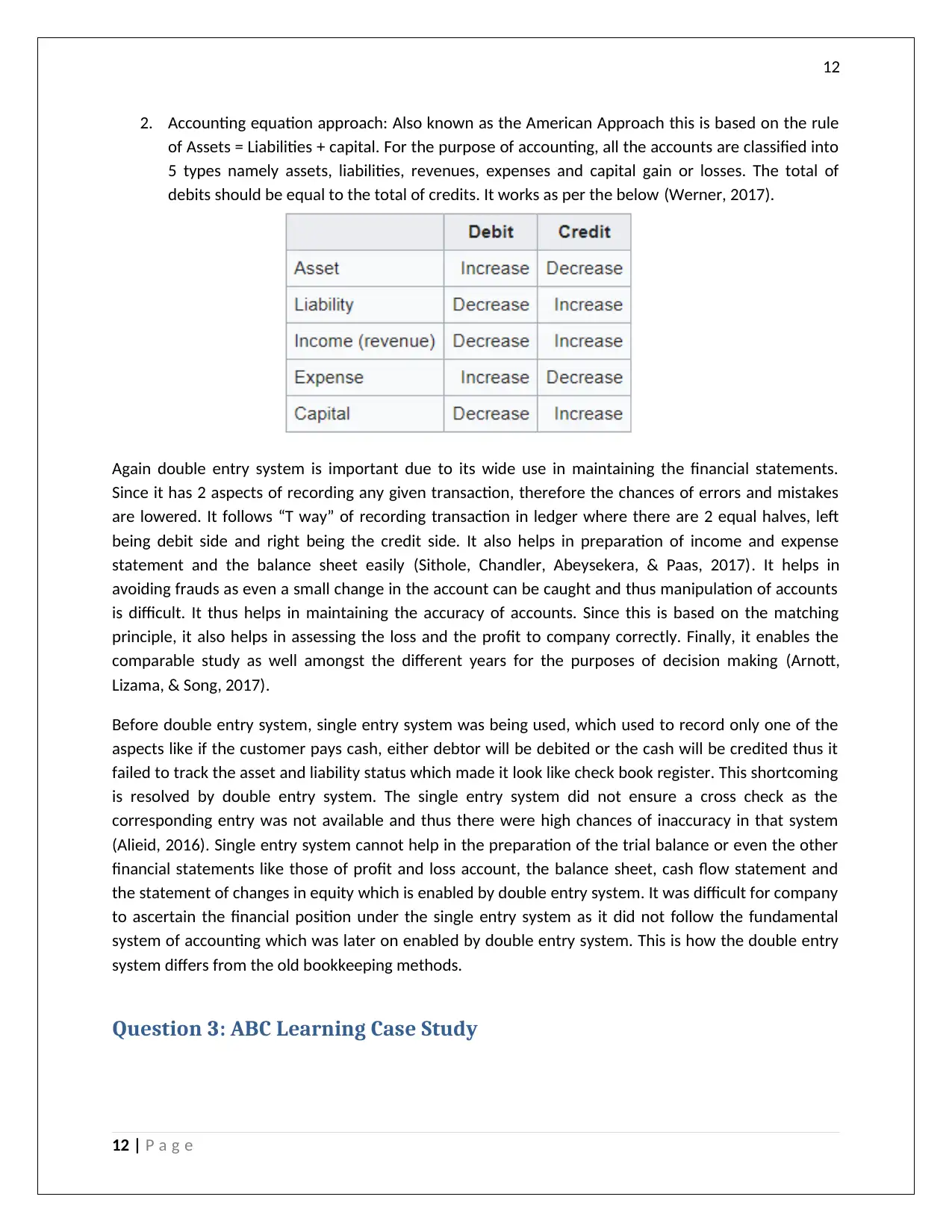
12
2. Accounting equation approach: Also known as the American Approach this is based on the rule
of Assets = Liabilities + capital. For the purpose of accounting, all the accounts are classified into
5 types namely assets, liabilities, revenues, expenses and capital gain or losses. The total of
debits should be equal to the total of credits. It works as per the below (Werner, 2017).
Again double entry system is important due to its wide use in maintaining the financial statements.
Since it has 2 aspects of recording any given transaction, therefore the chances of errors and mistakes
are lowered. It follows “T way” of recording transaction in ledger where there are 2 equal halves, left
being debit side and right being the credit side. It also helps in preparation of income and expense
statement and the balance sheet easily (Sithole, Chandler, Abeysekera, & Paas, 2017). It helps in
avoiding frauds as even a small change in the account can be caught and thus manipulation of accounts
is difficult. It thus helps in maintaining the accuracy of accounts. Since this is based on the matching
principle, it also helps in assessing the loss and the profit to company correctly. Finally, it enables the
comparable study as well amongst the different years for the purposes of decision making (Arnott,
Lizama, & Song, 2017).
Before double entry system, single entry system was being used, which used to record only one of the
aspects like if the customer pays cash, either debtor will be debited or the cash will be credited thus it
failed to track the asset and liability status which made it look like check book register. This shortcoming
is resolved by double entry system. The single entry system did not ensure a cross check as the
corresponding entry was not available and thus there were high chances of inaccuracy in that system
(Alieid, 2016). Single entry system cannot help in the preparation of the trial balance or even the other
financial statements like those of profit and loss account, the balance sheet, cash flow statement and
the statement of changes in equity which is enabled by double entry system. It was difficult for company
to ascertain the financial position under the single entry system as it did not follow the fundamental
system of accounting which was later on enabled by double entry system. This is how the double entry
system differs from the old bookkeeping methods.
Question 3: ABC Learning Case Study
12 | P a g e
2. Accounting equation approach: Also known as the American Approach this is based on the rule
of Assets = Liabilities + capital. For the purpose of accounting, all the accounts are classified into
5 types namely assets, liabilities, revenues, expenses and capital gain or losses. The total of
debits should be equal to the total of credits. It works as per the below (Werner, 2017).
Again double entry system is important due to its wide use in maintaining the financial statements.
Since it has 2 aspects of recording any given transaction, therefore the chances of errors and mistakes
are lowered. It follows “T way” of recording transaction in ledger where there are 2 equal halves, left
being debit side and right being the credit side. It also helps in preparation of income and expense
statement and the balance sheet easily (Sithole, Chandler, Abeysekera, & Paas, 2017). It helps in
avoiding frauds as even a small change in the account can be caught and thus manipulation of accounts
is difficult. It thus helps in maintaining the accuracy of accounts. Since this is based on the matching
principle, it also helps in assessing the loss and the profit to company correctly. Finally, it enables the
comparable study as well amongst the different years for the purposes of decision making (Arnott,
Lizama, & Song, 2017).
Before double entry system, single entry system was being used, which used to record only one of the
aspects like if the customer pays cash, either debtor will be debited or the cash will be credited thus it
failed to track the asset and liability status which made it look like check book register. This shortcoming
is resolved by double entry system. The single entry system did not ensure a cross check as the
corresponding entry was not available and thus there were high chances of inaccuracy in that system
(Alieid, 2016). Single entry system cannot help in the preparation of the trial balance or even the other
financial statements like those of profit and loss account, the balance sheet, cash flow statement and
the statement of changes in equity which is enabled by double entry system. It was difficult for company
to ascertain the financial position under the single entry system as it did not follow the fundamental
system of accounting which was later on enabled by double entry system. This is how the double entry
system differs from the old bookkeeping methods.
Question 3: ABC Learning Case Study
12 | P a g e
Paraphrase This Document
Need a fresh take? Get an instant paraphrase of this document with our AI Paraphraser
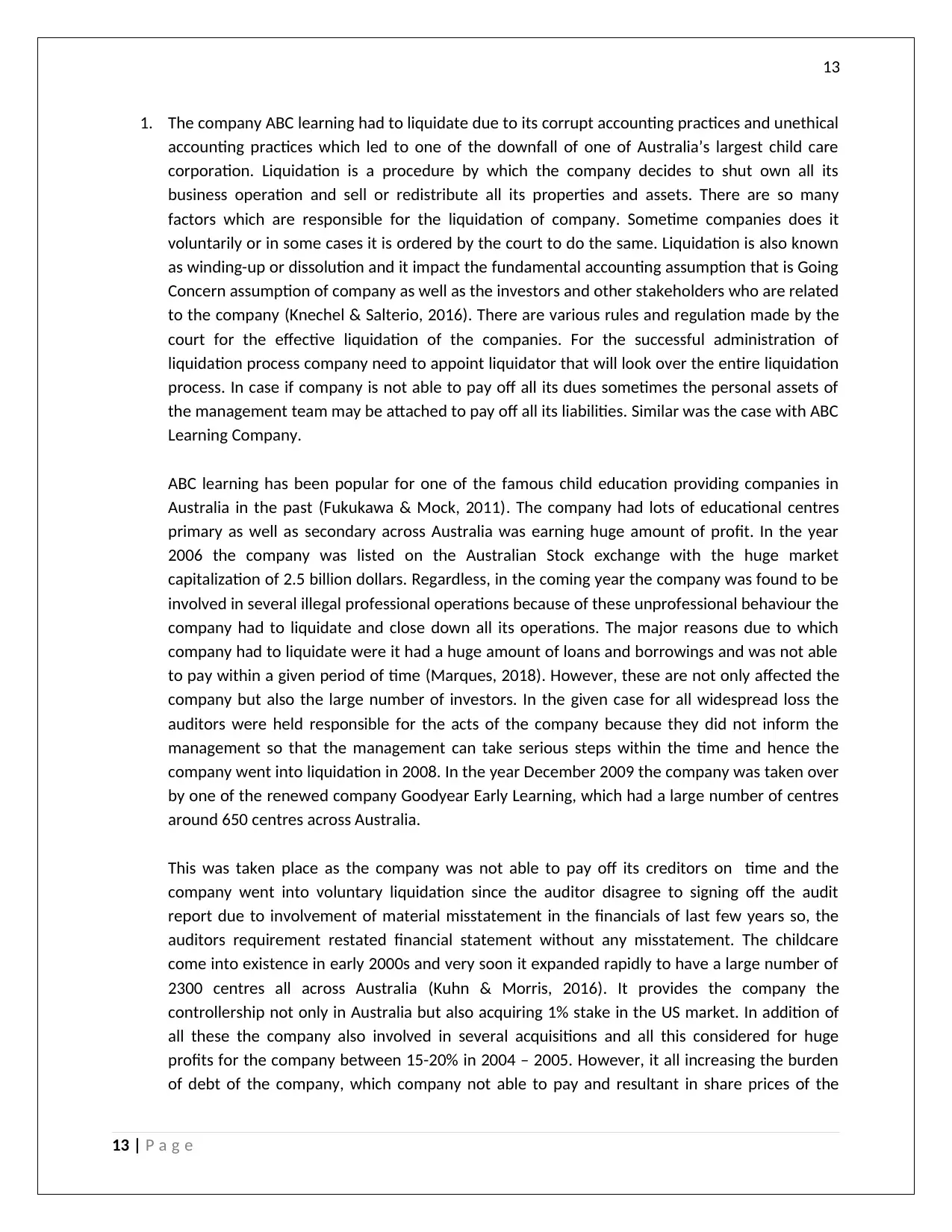
13
1. The company ABC learning had to liquidate due to its corrupt accounting practices and unethical
accounting practices which led to one of the downfall of one of Australia’s largest child care
corporation. Liquidation is a procedure by which the company decides to shut own all its
business operation and sell or redistribute all its properties and assets. There are so many
factors which are responsible for the liquidation of company. Sometime companies does it
voluntarily or in some cases it is ordered by the court to do the same. Liquidation is also known
as winding-up or dissolution and it impact the fundamental accounting assumption that is Going
Concern assumption of company as well as the investors and other stakeholders who are related
to the company (Knechel & Salterio, 2016). There are various rules and regulation made by the
court for the effective liquidation of the companies. For the successful administration of
liquidation process company need to appoint liquidator that will look over the entire liquidation
process. In case if company is not able to pay off all its dues sometimes the personal assets of
the management team may be attached to pay off all its liabilities. Similar was the case with ABC
Learning Company.
ABC learning has been popular for one of the famous child education providing companies in
Australia in the past (Fukukawa & Mock, 2011). The company had lots of educational centres
primary as well as secondary across Australia was earning huge amount of profit. In the year
2006 the company was listed on the Australian Stock exchange with the huge market
capitalization of 2.5 billion dollars. Regardless, in the coming year the company was found to be
involved in several illegal professional operations because of these unprofessional behaviour the
company had to liquidate and close down all its operations. The major reasons due to which
company had to liquidate were it had a huge amount of loans and borrowings and was not able
to pay within a given period of time (Marques, 2018). However, these are not only affected the
company but also the large number of investors. In the given case for all widespread loss the
auditors were held responsible for the acts of the company because they did not inform the
management so that the management can take serious steps within the time and hence the
company went into liquidation in 2008. In the year December 2009 the company was taken over
by one of the renewed company Goodyear Early Learning, which had a large number of centres
around 650 centres across Australia.
This was taken place as the company was not able to pay off its creditors on time and the
company went into voluntary liquidation since the auditor disagree to signing off the audit
report due to involvement of material misstatement in the financials of last few years so, the
auditors requirement restated financial statement without any misstatement. The childcare
come into existence in early 2000s and very soon it expanded rapidly to have a large number of
2300 centres all across Australia (Kuhn & Morris, 2016). It provides the company the
controllership not only in Australia but also acquiring 1% stake in the US market. In addition of
all these the company also involved in several acquisitions and all this considered for huge
profits for the company between 15-20% in 2004 – 2005. However, it all increasing the burden
of debt of the company, which company not able to pay and resultant in share prices of the
13 | P a g e
1. The company ABC learning had to liquidate due to its corrupt accounting practices and unethical
accounting practices which led to one of the downfall of one of Australia’s largest child care
corporation. Liquidation is a procedure by which the company decides to shut own all its
business operation and sell or redistribute all its properties and assets. There are so many
factors which are responsible for the liquidation of company. Sometime companies does it
voluntarily or in some cases it is ordered by the court to do the same. Liquidation is also known
as winding-up or dissolution and it impact the fundamental accounting assumption that is Going
Concern assumption of company as well as the investors and other stakeholders who are related
to the company (Knechel & Salterio, 2016). There are various rules and regulation made by the
court for the effective liquidation of the companies. For the successful administration of
liquidation process company need to appoint liquidator that will look over the entire liquidation
process. In case if company is not able to pay off all its dues sometimes the personal assets of
the management team may be attached to pay off all its liabilities. Similar was the case with ABC
Learning Company.
ABC learning has been popular for one of the famous child education providing companies in
Australia in the past (Fukukawa & Mock, 2011). The company had lots of educational centres
primary as well as secondary across Australia was earning huge amount of profit. In the year
2006 the company was listed on the Australian Stock exchange with the huge market
capitalization of 2.5 billion dollars. Regardless, in the coming year the company was found to be
involved in several illegal professional operations because of these unprofessional behaviour the
company had to liquidate and close down all its operations. The major reasons due to which
company had to liquidate were it had a huge amount of loans and borrowings and was not able
to pay within a given period of time (Marques, 2018). However, these are not only affected the
company but also the large number of investors. In the given case for all widespread loss the
auditors were held responsible for the acts of the company because they did not inform the
management so that the management can take serious steps within the time and hence the
company went into liquidation in 2008. In the year December 2009 the company was taken over
by one of the renewed company Goodyear Early Learning, which had a large number of centres
around 650 centres across Australia.
This was taken place as the company was not able to pay off its creditors on time and the
company went into voluntary liquidation since the auditor disagree to signing off the audit
report due to involvement of material misstatement in the financials of last few years so, the
auditors requirement restated financial statement without any misstatement. The childcare
come into existence in early 2000s and very soon it expanded rapidly to have a large number of
2300 centres all across Australia (Kuhn & Morris, 2016). It provides the company the
controllership not only in Australia but also acquiring 1% stake in the US market. In addition of
all these the company also involved in several acquisitions and all this considered for huge
profits for the company between 15-20% in 2004 – 2005. However, it all increasing the burden
of debt of the company, which company not able to pay and resultant in share prices of the
13 | P a g e
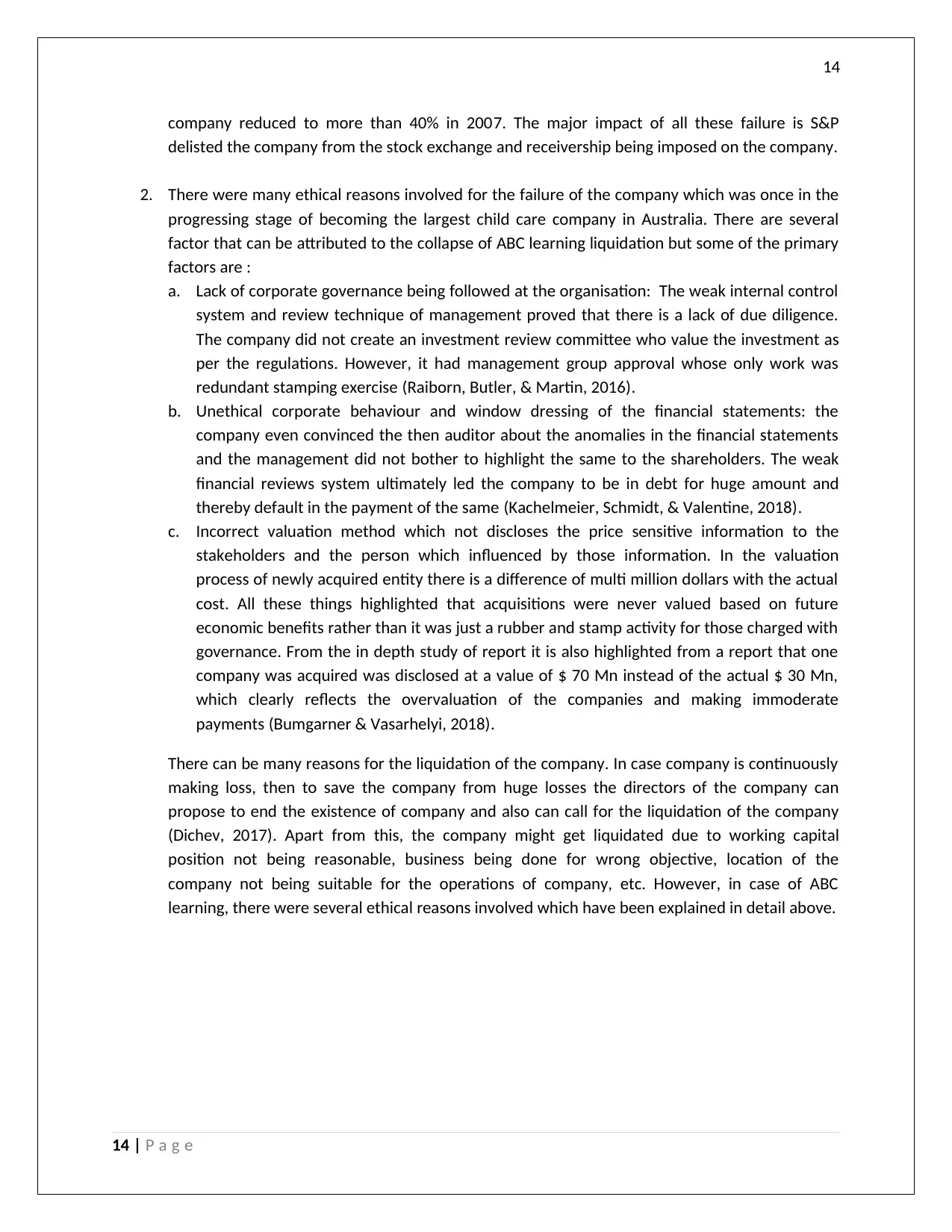
14
company reduced to more than 40% in 2007. The major impact of all these failure is S&P
delisted the company from the stock exchange and receivership being imposed on the company.
2. There were many ethical reasons involved for the failure of the company which was once in the
progressing stage of becoming the largest child care company in Australia. There are several
factor that can be attributed to the collapse of ABC learning liquidation but some of the primary
factors are :
a. Lack of corporate governance being followed at the organisation: The weak internal control
system and review technique of management proved that there is a lack of due diligence.
The company did not create an investment review committee who value the investment as
per the regulations. However, it had management group approval whose only work was
redundant stamping exercise (Raiborn, Butler, & Martin, 2016).
b. Unethical corporate behaviour and window dressing of the financial statements: the
company even convinced the then auditor about the anomalies in the financial statements
and the management did not bother to highlight the same to the shareholders. The weak
financial reviews system ultimately led the company to be in debt for huge amount and
thereby default in the payment of the same (Kachelmeier, Schmidt, & Valentine, 2018).
c. Incorrect valuation method which not discloses the price sensitive information to the
stakeholders and the person which influenced by those information. In the valuation
process of newly acquired entity there is a difference of multi million dollars with the actual
cost. All these things highlighted that acquisitions were never valued based on future
economic benefits rather than it was just a rubber and stamp activity for those charged with
governance. From the in depth study of report it is also highlighted from a report that one
company was acquired was disclosed at a value of $ 70 Mn instead of the actual $ 30 Mn,
which clearly reflects the overvaluation of the companies and making immoderate
payments (Bumgarner & Vasarhelyi, 2018).
There can be many reasons for the liquidation of the company. In case company is continuously
making loss, then to save the company from huge losses the directors of the company can
propose to end the existence of company and also can call for the liquidation of the company
(Dichev, 2017). Apart from this, the company might get liquidated due to working capital
position not being reasonable, business being done for wrong objective, location of the
company not being suitable for the operations of company, etc. However, in case of ABC
learning, there were several ethical reasons involved which have been explained in detail above.
14 | P a g e
company reduced to more than 40% in 2007. The major impact of all these failure is S&P
delisted the company from the stock exchange and receivership being imposed on the company.
2. There were many ethical reasons involved for the failure of the company which was once in the
progressing stage of becoming the largest child care company in Australia. There are several
factor that can be attributed to the collapse of ABC learning liquidation but some of the primary
factors are :
a. Lack of corporate governance being followed at the organisation: The weak internal control
system and review technique of management proved that there is a lack of due diligence.
The company did not create an investment review committee who value the investment as
per the regulations. However, it had management group approval whose only work was
redundant stamping exercise (Raiborn, Butler, & Martin, 2016).
b. Unethical corporate behaviour and window dressing of the financial statements: the
company even convinced the then auditor about the anomalies in the financial statements
and the management did not bother to highlight the same to the shareholders. The weak
financial reviews system ultimately led the company to be in debt for huge amount and
thereby default in the payment of the same (Kachelmeier, Schmidt, & Valentine, 2018).
c. Incorrect valuation method which not discloses the price sensitive information to the
stakeholders and the person which influenced by those information. In the valuation
process of newly acquired entity there is a difference of multi million dollars with the actual
cost. All these things highlighted that acquisitions were never valued based on future
economic benefits rather than it was just a rubber and stamp activity for those charged with
governance. From the in depth study of report it is also highlighted from a report that one
company was acquired was disclosed at a value of $ 70 Mn instead of the actual $ 30 Mn,
which clearly reflects the overvaluation of the companies and making immoderate
payments (Bumgarner & Vasarhelyi, 2018).
There can be many reasons for the liquidation of the company. In case company is continuously
making loss, then to save the company from huge losses the directors of the company can
propose to end the existence of company and also can call for the liquidation of the company
(Dichev, 2017). Apart from this, the company might get liquidated due to working capital
position not being reasonable, business being done for wrong objective, location of the
company not being suitable for the operations of company, etc. However, in case of ABC
learning, there were several ethical reasons involved which have been explained in detail above.
14 | P a g e
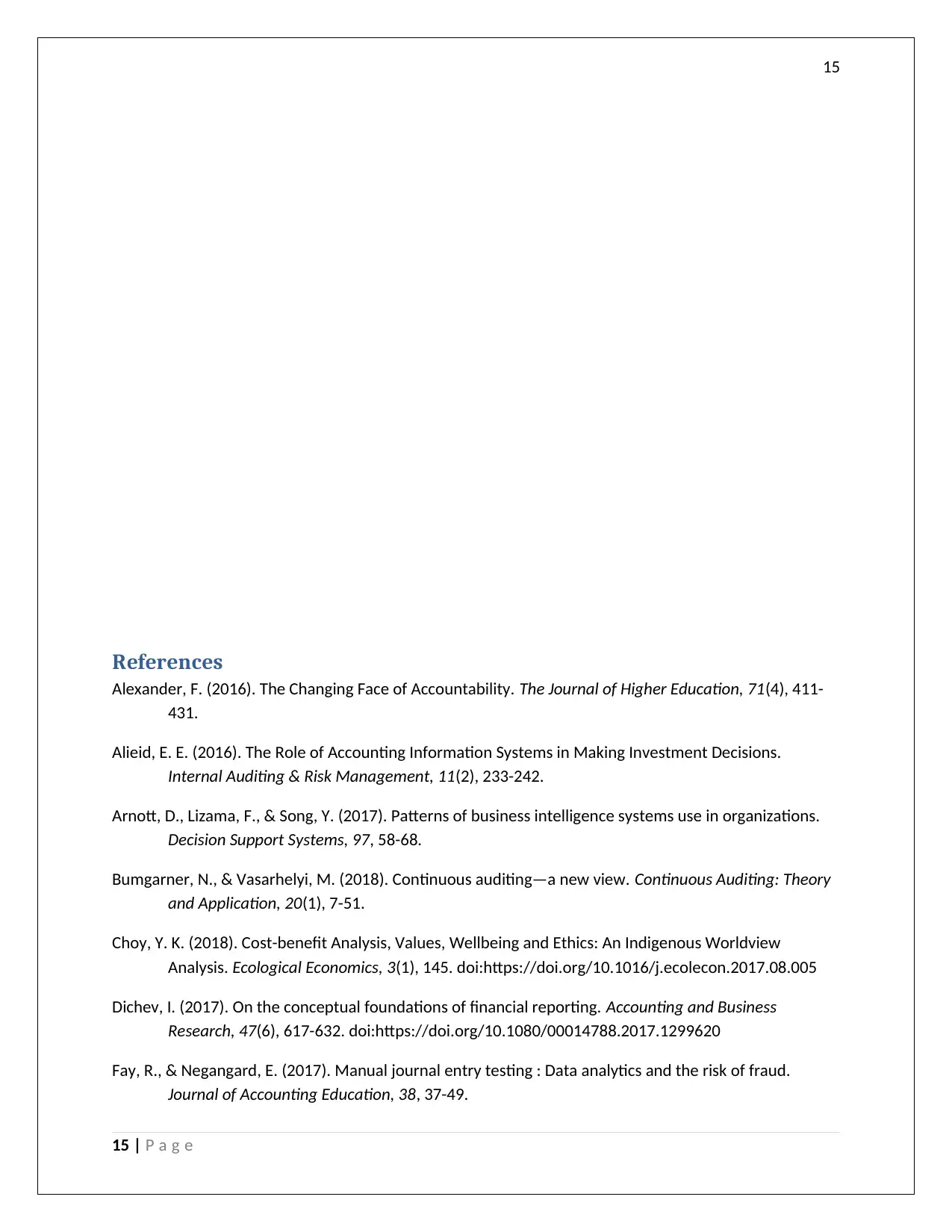
15
References
Alexander, F. (2016). The Changing Face of Accountability. The Journal of Higher Education, 71(4), 411-
431.
Alieid, E. E. (2016). The Role of Accounting Information Systems in Making Investment Decisions.
Internal Auditing & Risk Management, 11(2), 233-242.
Arnott, D., Lizama, F., & Song, Y. (2017). Patterns of business intelligence systems use in organizations.
Decision Support Systems, 97, 58-68.
Bumgarner, N., & Vasarhelyi, M. (2018). Continuous auditing—a new view. Continuous Auditing: Theory
and Application, 20(1), 7-51.
Choy, Y. K. (2018). Cost-benefit Analysis, Values, Wellbeing and Ethics: An Indigenous Worldview
Analysis. Ecological Economics, 3(1), 145. doi:https://doi.org/10.1016/j.ecolecon.2017.08.005
Dichev, I. (2017). On the conceptual foundations of financial reporting. Accounting and Business
Research, 47(6), 617-632. doi:https://doi.org/10.1080/00014788.2017.1299620
Fay, R., & Negangard, E. (2017). Manual journal entry testing : Data analytics and the risk of fraud.
Journal of Accounting Education, 38, 37-49.
15 | P a g e
References
Alexander, F. (2016). The Changing Face of Accountability. The Journal of Higher Education, 71(4), 411-
431.
Alieid, E. E. (2016). The Role of Accounting Information Systems in Making Investment Decisions.
Internal Auditing & Risk Management, 11(2), 233-242.
Arnott, D., Lizama, F., & Song, Y. (2017). Patterns of business intelligence systems use in organizations.
Decision Support Systems, 97, 58-68.
Bumgarner, N., & Vasarhelyi, M. (2018). Continuous auditing—a new view. Continuous Auditing: Theory
and Application, 20(1), 7-51.
Choy, Y. K. (2018). Cost-benefit Analysis, Values, Wellbeing and Ethics: An Indigenous Worldview
Analysis. Ecological Economics, 3(1), 145. doi:https://doi.org/10.1016/j.ecolecon.2017.08.005
Dichev, I. (2017). On the conceptual foundations of financial reporting. Accounting and Business
Research, 47(6), 617-632. doi:https://doi.org/10.1080/00014788.2017.1299620
Fay, R., & Negangard, E. (2017). Manual journal entry testing : Data analytics and the risk of fraud.
Journal of Accounting Education, 38, 37-49.
15 | P a g e
Secure Best Marks with AI Grader
Need help grading? Try our AI Grader for instant feedback on your assignments.
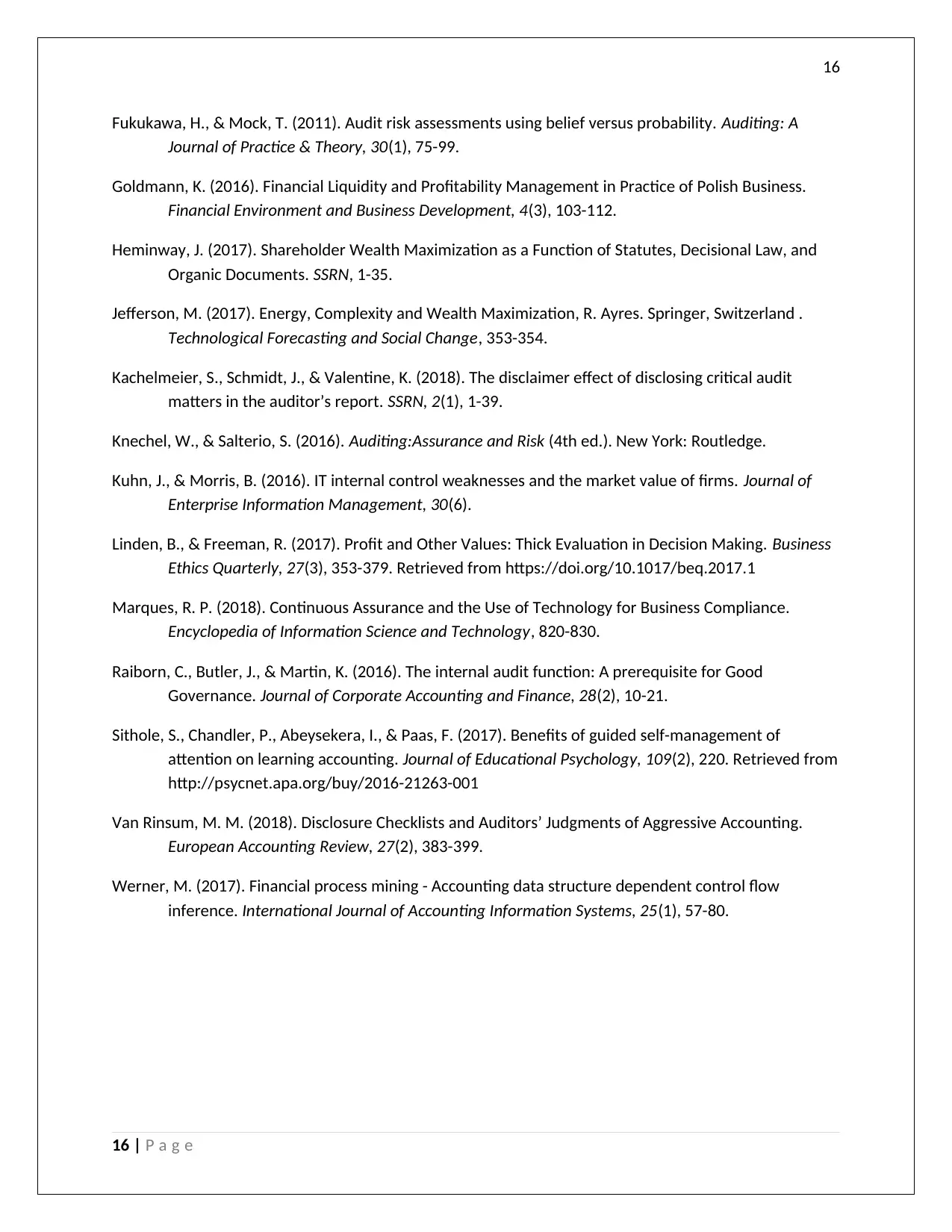
16
Fukukawa, H., & Mock, T. (2011). Audit risk assessments using belief versus probability. Auditing: A
Journal of Practice & Theory, 30(1), 75-99.
Goldmann, K. (2016). Financial Liquidity and Profitability Management in Practice of Polish Business.
Financial Environment and Business Development, 4(3), 103-112.
Heminway, J. (2017). Shareholder Wealth Maximization as a Function of Statutes, Decisional Law, and
Organic Documents. SSRN, 1-35.
Jefferson, M. (2017). Energy, Complexity and Wealth Maximization, R. Ayres. Springer, Switzerland .
Technological Forecasting and Social Change, 353-354.
Kachelmeier, S., Schmidt, J., & Valentine, K. (2018). The disclaimer effect of disclosing critical audit
matters in the auditor’s report. SSRN, 2(1), 1-39.
Knechel, W., & Salterio, S. (2016). Auditing:Assurance and Risk (4th ed.). New York: Routledge.
Kuhn, J., & Morris, B. (2016). IT internal control weaknesses and the market value of firms. Journal of
Enterprise Information Management, 30(6).
Linden, B., & Freeman, R. (2017). Profit and Other Values: Thick Evaluation in Decision Making. Business
Ethics Quarterly, 27(3), 353-379. Retrieved from https://doi.org/10.1017/beq.2017.1
Marques, R. P. (2018). Continuous Assurance and the Use of Technology for Business Compliance.
Encyclopedia of Information Science and Technology, 820-830.
Raiborn, C., Butler, J., & Martin, K. (2016). The internal audit function: A prerequisite for Good
Governance. Journal of Corporate Accounting and Finance, 28(2), 10-21.
Sithole, S., Chandler, P., Abeysekera, I., & Paas, F. (2017). Benefits of guided self-management of
attention on learning accounting. Journal of Educational Psychology, 109(2), 220. Retrieved from
http://psycnet.apa.org/buy/2016-21263-001
Van Rinsum, M. M. (2018). Disclosure Checklists and Auditors’ Judgments of Aggressive Accounting.
European Accounting Review, 27(2), 383-399.
Werner, M. (2017). Financial process mining - Accounting data structure dependent control flow
inference. International Journal of Accounting Information Systems, 25(1), 57-80.
16 | P a g e
Fukukawa, H., & Mock, T. (2011). Audit risk assessments using belief versus probability. Auditing: A
Journal of Practice & Theory, 30(1), 75-99.
Goldmann, K. (2016). Financial Liquidity and Profitability Management in Practice of Polish Business.
Financial Environment and Business Development, 4(3), 103-112.
Heminway, J. (2017). Shareholder Wealth Maximization as a Function of Statutes, Decisional Law, and
Organic Documents. SSRN, 1-35.
Jefferson, M. (2017). Energy, Complexity and Wealth Maximization, R. Ayres. Springer, Switzerland .
Technological Forecasting and Social Change, 353-354.
Kachelmeier, S., Schmidt, J., & Valentine, K. (2018). The disclaimer effect of disclosing critical audit
matters in the auditor’s report. SSRN, 2(1), 1-39.
Knechel, W., & Salterio, S. (2016). Auditing:Assurance and Risk (4th ed.). New York: Routledge.
Kuhn, J., & Morris, B. (2016). IT internal control weaknesses and the market value of firms. Journal of
Enterprise Information Management, 30(6).
Linden, B., & Freeman, R. (2017). Profit and Other Values: Thick Evaluation in Decision Making. Business
Ethics Quarterly, 27(3), 353-379. Retrieved from https://doi.org/10.1017/beq.2017.1
Marques, R. P. (2018). Continuous Assurance and the Use of Technology for Business Compliance.
Encyclopedia of Information Science and Technology, 820-830.
Raiborn, C., Butler, J., & Martin, K. (2016). The internal audit function: A prerequisite for Good
Governance. Journal of Corporate Accounting and Finance, 28(2), 10-21.
Sithole, S., Chandler, P., Abeysekera, I., & Paas, F. (2017). Benefits of guided self-management of
attention on learning accounting. Journal of Educational Psychology, 109(2), 220. Retrieved from
http://psycnet.apa.org/buy/2016-21263-001
Van Rinsum, M. M. (2018). Disclosure Checklists and Auditors’ Judgments of Aggressive Accounting.
European Accounting Review, 27(2), 383-399.
Werner, M. (2017). Financial process mining - Accounting data structure dependent control flow
inference. International Journal of Accounting Information Systems, 25(1), 57-80.
16 | P a g e
1 out of 17
Related Documents
Your All-in-One AI-Powered Toolkit for Academic Success.
+13062052269
info@desklib.com
Available 24*7 on WhatsApp / Email
![[object Object]](/_next/static/media/star-bottom.7253800d.svg)
Unlock your academic potential
© 2024 | Zucol Services PVT LTD | All rights reserved.





